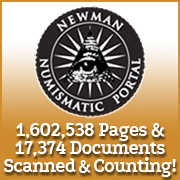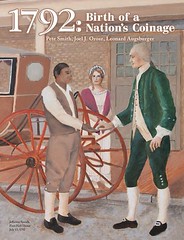
About UsThe Numismatic Bibliomania Society is a non-profit organization devoted to the study and enjoyment of numismatic literature. For more information please see our web site at coinbooks.org SubscriptionsThose wishing to become new E-Sylum subscribers (or wishing to Unsubscribe) can go to the following web page link MembershipThere is a membership application available on the web site Membership Application To join, print the application and return it with your check to the address printed on the application. Print/Digital membership is $40 to addresses in the U.S., and $60 elsewhere. A digital-only membership is available for $25. For those without web access, write to: Terry White, Treasurer AsylumFor Asylum mailing address changes and other membership questions, contact Terry at this email address: terrywhite5475@yahoo.com SubmissionsTo submit items for publication in The E-Sylum, just Reply to this message, or write to the Editor at this address: whomren@gmail.com BUY THE BOOK BEFORE THE COINSale Calendar |
- WAYNE'S WORDS: THE E-SYLUM NOVEMBER 19, 2017
- ASYLUM WINTER 2017 ISSUE PUBLISHED
- BURD LIBRARY HIGHLIGHTS: WORLD NUMISMATICS
- CANADIAN ERROR MANUAL OFFER
- THE EARLIEST (KNOWN) NUMISMATIC WRITER?
- GERALD L. KOCHEL (1932-2017)
- NEWMAN PORTAL ADDS ANS CENTENNIAL HISTORY
- NEWMAN PORTAL SEARCH: “JULY 12, 1709”
- ANA OFFERS MARCH 2018 GRADING COURSES
- QUERIES: PICASSO AND ROYAL TOUCH GOLD COINS
- NOTES FROM E-SYLUM READERS: NOVEMBER 19, 2017
- VOCABULARY TERMS: ONE LINERS
- HERBERT ELLIS MOREY (1848-1925)
- HARVEY STACK'S NUMISMATIC FAMILY, PART 5
- MORE ON LIFE OF ERIC P. NEWMAN
- MORE TRIBUTES TO ERIC P. NEWMAN
- MORE ON ROBERT MARTIN AND THE MIDNIGHT SALE
- 1792 SILVER AND NON-SILVER CENTER CENTS STUDY
- COPPER-PLATED ZINC CENT BLANK DISCOVERY
- AWARD MEDALS OF GEORGE DE HEVESY OFFERED
- COIN MARKS 50TH ANNIVERSARY OF SEALAND MICRONATION
- MACERATED CURRENCY BUST OF PRESIDENT HARRISON
- A LIST OF COIN MAKER WEB SITES
- RICHARD III GOLD HALF ANGEL UNEARTHED
- ISLAMIC GOLD COIN HOARD UNEARTHED IN FRANCE
- SPECIAL FORCES DOG AWARDED DICKIN MEDAL
- KYRGYZ REPUBLIC BANKNOTE USES MOTION SURFACE
- THE GHOST AND THE WIDOW'S MITES
- FEATURED WEB SITE: MUSEUM OF THE ITALIAN MINT
Click here to access the complete archive
To comment or submit articles, reply to whomren@gmail.com
Content presented in The E-Sylum is not necessarily researched or independently fact-checked, and views expressed do not necessarily represent those of the Numismatic Bibliomania Society.
WAYNE'S WORDS: THE E-SYLUM NOVEMBER 19, 2017
 New subscribers this week include: Rick Beleson in San Francisco, courtesy of David Hendin; Jill Anderson and Richard Schlatter, courtesy of Joel Orosz; Rob Oberth, courtesy of Susan Trask;
Ryan Delane, courtesy of Ron Guth; and Michael Dlugosz. Welcome aboard! We now have 3,319 subscribers.
New subscribers this week include: Rick Beleson in San Francisco, courtesy of David Hendin; Jill Anderson and Richard Schlatter, courtesy of Joel Orosz; Rob Oberth, courtesy of Susan Trask;
Ryan Delane, courtesy of Ron Guth; and Michael Dlugosz. Welcome aboard! We now have 3,319 subscribers.
Thank you for reading The E-Sylum. If you enjoy it, please send me the email addresses of friends you think may enjoy it as well and I'll send them a subscription with your compliments. Contact me at whomren@gmail.com anytime regarding your subscription, or questions, comments or suggestions about our content.
This week we open with a new issue of The Asylum, world numismatic literature highlights from the Burd library. Other topics this week include the earliest numismatic author, Newman Portal updates, Jerry Kochel, H. E. Morey, Eric P. Newman, coin makers, and the famous "Midnight Sale".
To learn more about Canadian Errors and Varieties, New York engravers Ephraim Brasher and John Bailey, Royal Touch gold coins, the U.S. Mint Numismatic Library, foliated edges, the George Clapp Collection, 1792 Silver and Non-Silver Center Cents, the Royal Society’s Copley Medal, the ghost and the Widow's Mites, and the Macerated Currency Bust of President Benjamin Harrison, read on. Have a great week, everyone!
Wayne Homren
Editor, The E-Sylum
ASYLUM WINTER 2017 ISSUE PUBLISHED
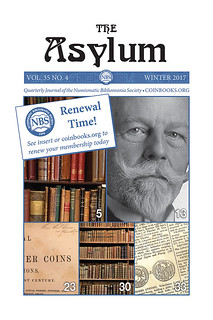 The Asylum
The Asylum
Winter 2017 Volume 35 No. 4
Table of Contents:
The Nineteenth-Century Bookcase By David Gladfelter
Off the Shelf: Max von Bahrfeldt By David F. Fanning
ASSOCIATIONS: Autographs, Annotations, Inscriptions: William E. Burr’s Jacob Eckfeldt-Inscribed By Joel J. Orosz
How to Make Your Numismatic Library Work For You By Shanna Schmidt
A to V: Seth Stevenson By David R. Pickup
Message from the President
By Tom Harrison
Greetings and welcome to the winter issue of your award-winning journal, The Asylum. Today, as an increasing number of collectors pursue an ever greater portion of their collecting experience online, it is vital to be mindful of the significance of our person-to-person connectivity. Unquestionably, the internet is a valuable tool for research and for bonding with fellow bibliophiles. However, it cannot replace the memories created by spending a day visiting a friend’s library and recounting our collecting experiences. Nor can it replace the benefits of attending NBS sponsored events at an ANA Convention while linking up with old friends and making new acquaintances.
When long-time collectors reflect on their collecting journey, they frequently relate that the thrill of the hunt or the satisfaction of achieving a defined goal are secondary to the friendships and personal experiences enjoyed over the years. By sharing our enthusiasm for numismatic literature with fellow bibliophiles, we not only exponentially enhance our own collecting experience, but we also strengthen the foundation of our hobby. As we look forward to 2018, will you please join me in keeping a watchful eye for opportunities to build personal connections with your fellow NBS members? May your numismatic library provide investigation, discovery and most of all, enjoyment.
NBS Membership Renewal Time!
It’s time to renew your NBS Membership and subscription to The Asylum! Your membership expiration date will appear on your printed copy’s envelope. Renew online at coinbooks.org.
To join NBS or renew your annual membership, see: http://www.coinbooks.org/about/membership.html
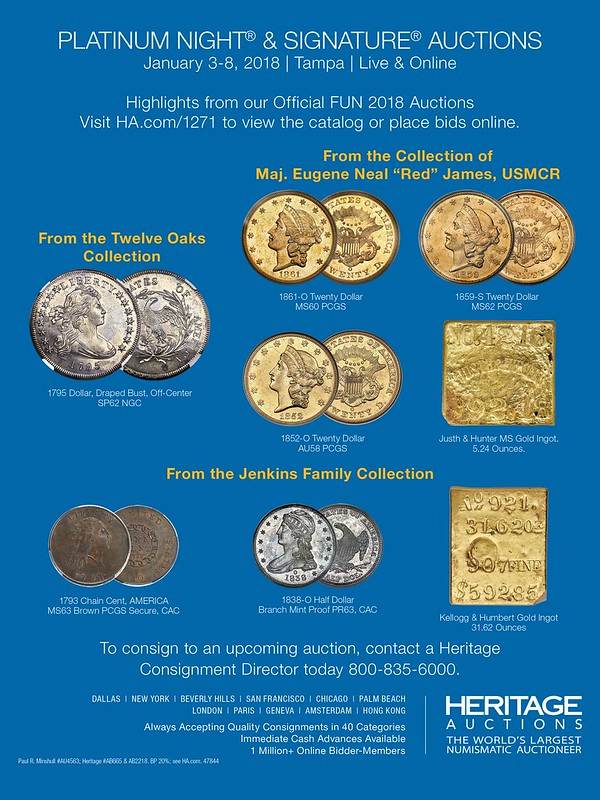
BURD LIBRARY HIGHLIGHTS: WORLD NUMISMATICS
HIGHLIGHTS FROM THE WILLIAM A. BURD LIBRARY: WORLD NUMISMATICS
Kolbe & Fanning Numismatic Booksellers will be offering highlights from the outstanding numismatic library formed by Chicagoan William A. Burd in our 2018 New York Book Auction, which will be held in conjunction with the New York International Numismatic Convention on Saturday, January 13, 2018 at the Grand Hyatt hotel in Manhattan.
The catalogue has been sent to the printers, and we wanted to give readers a small preview of what they have to look forward to. The following are some highlights from the Burd Library’s offerings of material on world coins:
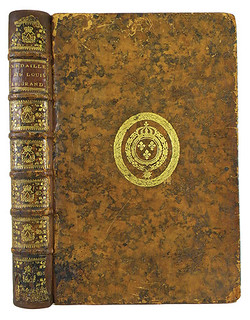

Lots 135 and 140
Lot 135: the rare first issue of the magnificent 1702 first edition of Médailles sur les principaux événements du règne de Louis le Grand, with the suppressed Préface
Lot 140: the extraordinary Numismata Virorum Illustrium ex Barbadica Gente of 1732, with the very rare 1760 supplement

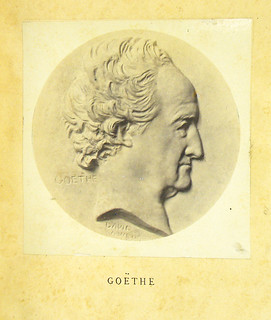
Lots 161 and 174
Lot 161: the Coats Family’s large-paper set of Burns on The Coinage of Scotland (1887)
Lot 174: Les Médaillons de David d’Angers (1867), one of the earliest extensive uses of photography in a numismatic book
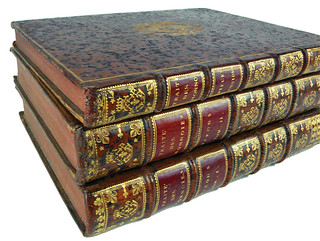
Lot 184
Lot 184: a regal set of Duby’s rare works on obsidional and French feudal coins (1786 & 1790), in exceptional armorial bindings of Louis XVI

Lot 197
Lot 197: Pietro Antonio Gaetani’s 1761-1763 folio catalogue of Count Giovanni Maria Mazzuchelli’s magnificent collection of medals
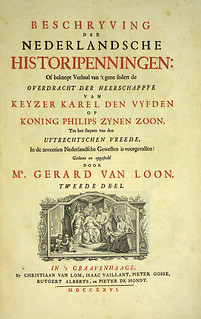
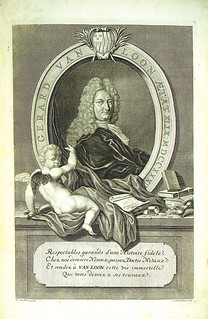
Lots 221 and 222
Lots 221 & 222: original Dutch and French sets of Van Loon’s foundational work on Dutch medals

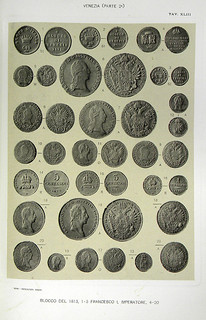
Lots 268 and 298
Lot 268: a superb example of Ricaud de Tiregale’s masterwork on Russian medals
Lot 298: the Clain-Stefanellis’ original set of Corpus Nummorum Italicorum.
A number of other wonderful publications could be listed above. Included in the sale, for instance, are no fewer than eight first edition numismatic works by José Toribio Medina, many additional volumes on medals, a variety of compilations on seals, and important books on Chinese coins and paper money. Selected highlights from the North American segment of the Burd Library will be revealed next week.
The online catalogue for our New York Book Auction should be available by the end of the month. Printed catalogues will be available in December.
Kolbe & Fanning Numismatic Booksellers are a licensed auction firm specializing in the sale of rare and out-of-print numismatic literature. We also sell new and secondhand numismatic books on a retail basis through our website at numislit.com. To subscribe to our email list, please see numislit.com or contact David Fanning at df@numislit.com.
To read the earlier E-Sylum article, see:
BURD LIBRARY HIGHLIGHTS: ANCIENT NUMISMATICS (http://www.coinbooks.org/v20/esylum_v20n46a02.html)
THE BOOK BAZARRE
CANADIAN ERROR MANUAL OFFER
 My 530-page Errors & Varieties Educational Manual, featuring the minting process at the Royal Canadian Mint from about the 1950s up to the 1980s and all the errors that the equipment
was capable of producing, is normally selling for $100 Canadian funds, plus shipping. Over half the pages are in full colour, all housed in a 3-ring binder. My collection of Canadian errors has been
acknowledged as the most complete typeset of Canadian errors ever assembled by one person, and colour photographs are included of them in the appropriate chapters.
My 530-page Errors & Varieties Educational Manual, featuring the minting process at the Royal Canadian Mint from about the 1950s up to the 1980s and all the errors that the equipment
was capable of producing, is normally selling for $100 Canadian funds, plus shipping. Over half the pages are in full colour, all housed in a 3-ring binder. My collection of Canadian errors has been
acknowledged as the most complete typeset of Canadian errors ever assembled by one person, and colour photographs are included of them in the appropriate chapters.
I will be visiting relatives in Ohio for the next two weeks and will be taking a few copies with me. If any E-Sylum readers are interested in purchasing it, they should e-mail me at errorman@look.ca before November 24 and I will mail them a copy via USPS. If they like what they see, they can mail me a check for $60 U.S. funds total. If they don't like what they see, they can return it to the Ohio address that will be included in the shipment, no questions asked. However, if they decide to return it within a few weeks after receipt, I expect them to pick up the return shipping cost.
I will be including a full set of reprints of 14 KAYAK magazines, official publication of the Coin Irregularity Association of Canada (CIAC) dated January 1970 to April 1971 as a bonus. To make up for the cost of return postage, anyone not satisfied can keep the KAYAK magazines.
I don't expect anyone to take advantage of this special offer by returning the book just to get the magazines.
If anyone wishes additional information as to its content, they should send me an e-mail.

THE EARLIEST (KNOWN) NUMISMATIC WRITER?
Tom Fort writes:
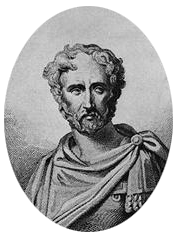 I found the following article online: The Body of the Earliest (Known) Numismatic Writer?
I found the following article online: The Body of the Earliest (Known) Numismatic Writer?
Assuming that the remains are those of Pliny the Elder (and that is a huge IF) then we also have the remains of the earliest known numismatic writer. In his The Natural History (written c. AD 77-79) Pliny gives a brief history of Roman coinage.
Almost everything that Pliny says is wrong. But he was a principal source for Roman historians and numismatists until the 1950s when Rudi Thomsen's Early Roman Coinage, 3 vols. (Copenhagen, 1957) conclusively demonstrated that Pliny's statements were useless as accurate historical evidence. Nevertheless, his passage is the only source from the ancient world to discuss coinage at any length and it was highly influential in numismatic scholarship for over four centuries during the late mediaeval and modern periods.
Italian scientists are a few thousand euros and a test tube away from conclusively identifying the body of Pliny the Elder, the Roman polymath, writer and military leader who launched a naval rescue operation to save the people of Pompeii from the deadly eruption of Mt. Vesuvius 2,000 years ago.
If successful, the effort would mark the first positive identification of the remains of a high-ranking figure from ancient Rome, highlighting the work of a man who lost his life while leading history's first large-scale rescue operation, and who also wrote one of the world's earliest encyclopedias.
The remains now believed to be Pliny's were found more than a century ago. But identifying the body has only recently become feasible, says Andrea Cionci, an art historian and journalist who last week reported the findings in the Italian daily La Stampa.
To read the complete article, see:
Pompeii Hero Pliny the Elder May Have Been Found 2,000 Years Later (https://www.haaretz.com/world-news/1.809751)
To read an English translation of Pliny, see:
Pliny the Elder, The Natural History
(http://www.perseus.tufts.edu/hopper/text?doc=Perseus%3Atext%3A1999.02.0137%3Abook%3D33%3Achapter%3D13)
GERALD L. KOCHEL (1932-2017)
 Gerald "Jerry" L. Kochel, 85, of Lititz, passed away on Friday, November 10th, 2017, at Landis Homes.
Gerald "Jerry" L. Kochel, 85, of Lititz, passed away on Friday, November 10th, 2017, at Landis Homes.
He was born in Ephrata, PA on October 23rd, 1932 to the late Harold and Lillian C. (Christiansen) Kochel and was the husband of Sandra Adams.
He was a member of Lititz United Methodist Church for many years.
Jerry was a life-long coin collector and a member of Red Rose Coin Club, Lebanon Valley Coin Club, American Numismatic Association, Central States Numismatic Association, Florida United Numismatists, and PAN-Pennsylvania Association of Numismatists.
He was an avid baseball fan, cheering for the Phillies (his favorite team).
He was a lifetime member of the Lititz VFW and Lititz Legion, a charter member and Treasurer of the Young Men's Business League (Lititz) and a member of the Lancaster Liederkranz, Lancaster AMVETS and Ephrata Elks Lodge 1933.
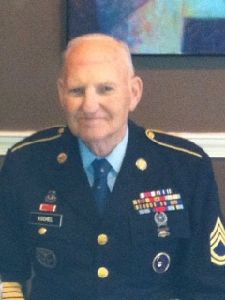 Jerry was a proud United States Military veteran, serving in the Army and National Guard for over 20 years. He retired from Kerr Glass after 40 years of service.
Jerry was a proud United States Military veteran, serving in the Army and National Guard for over 20 years. He retired from Kerr Glass after 40 years of service.
Jerry collected primarily U.S. coins, and was a prolific exhibitor. Two of his exhibits were a complete set of Liberty Seated Half Dimes and Half Cent errors. I learned to exhibit under the tutelage of John and Jerry. To this day the PAN shows punch far above their weight with national-quality exhibits in a regional show.
Jerry had a marvelous sense of humor and always brought smiles, especially when he served as auctioneer at the PAN annual banquet. At one of the Pittsburgh ANA conventions he reduced the banquet audience to tears of laughter with his Pennsylvania Dutch farmer routine.
Great numismatist, hardworking volunteer, talented mentor; Jerry was an original who will be sorely missed. -Editor

Photo by Barbara Gregory of John Eshbach (left)
and Jerry Kochel at the 2011 PAN Banquet in Pittsburgh.
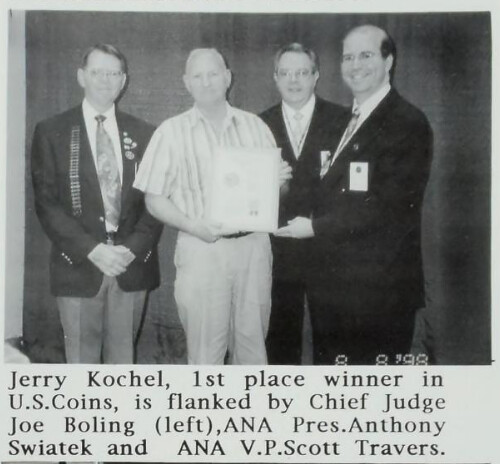
From The Clarion September 1998

From The Clarion September 2002
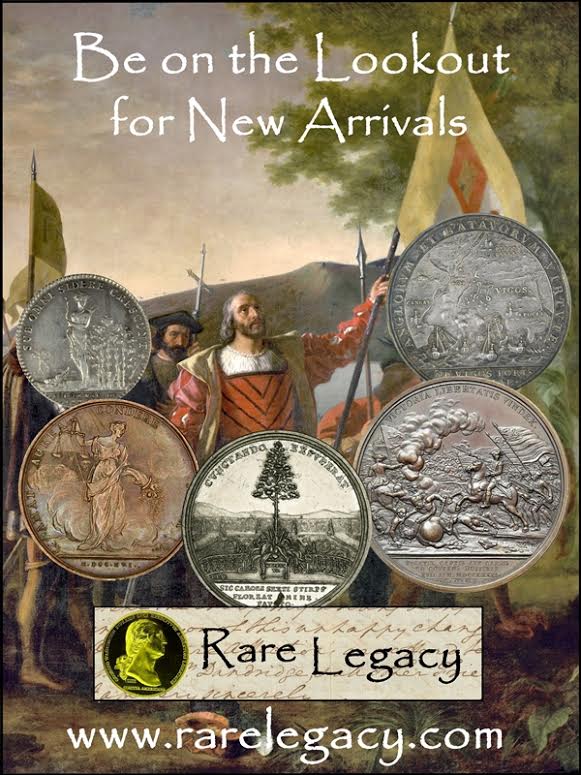
NEWMAN PORTAL ADDS ANS CENTENNIAL HISTORY
Several weeks ago a Newman Portal user expressed surprise that the American Numismatic Society Centennial History (1958) was not found on NNP. With the kind permission of the ANS, this volume is now available. The work was published by ANS as a commemoration of its 100-year anniversary and contained papers on a wide range of numismatic topics. Among U.S. authors, Eric Newman and Walter Breen were granted the honor of making contributions on American numismatics.
Breen wrote on the early New York engravers Ephraim Brasher and John Bailey, while Newman tackled the mystery of British insignia appearing on post-revolution Vermont state coppers. The problem had vexed researchers as long as the ANS was old, and Newman used a recently excavated example of a counterfeit British halfpence to demonstrate punch-linking between that series and the Vermont coppers. The reconciliation of the historical record with the evidence of the coins themselves is the essence of the numismatic research, showcasing Newman’s ability to attack a problem from multiple directions, advancing the science of numismatics and establishing a high standard for future efforts.
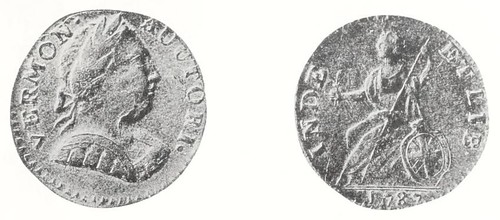
Image: Ryder-14 Vermont copper, showing British emblem in the shield, from the Centennial History
Link to ANS Centennial History on NNP:
https://nnp.wustl.edu/library/book/538305
NEWMAN PORTAL SEARCH: “JULY 12, 1709”
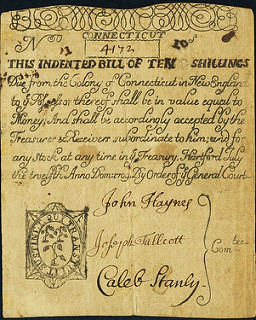

Colony of Connecticut July 12, 1709 3 Shillings Raised to 10 Shillings note
A Newman Portal user this week entered the date “July 12, 1709” into the NNP search. As happens weekly, the search stumps me – I might have done better if they entered “1909-S V.D.B.” instead. It turns out this refers to the inaugural appearance of Connecticut paper money (more precisely a bill of credit), issued pursuant to a May 1709 act “to pay for an aborted expedition against Canada,” per Eric Newman’s Early Paper Money of America.
The notes were valid for satisfying tax obligations but not as legal tender. The example illustrated sold in Heritage Auctions’ Newman VII sale (October 2015, lot 18024), for $15,275. Newman’s working notes on this emission are found in the Harley Freeman colonial currency inventory. Newman acquired the Freeman collection in 1963 and extensively edited Freeman’s inventory, leading to the first edition of Early Paper Money in 1967.
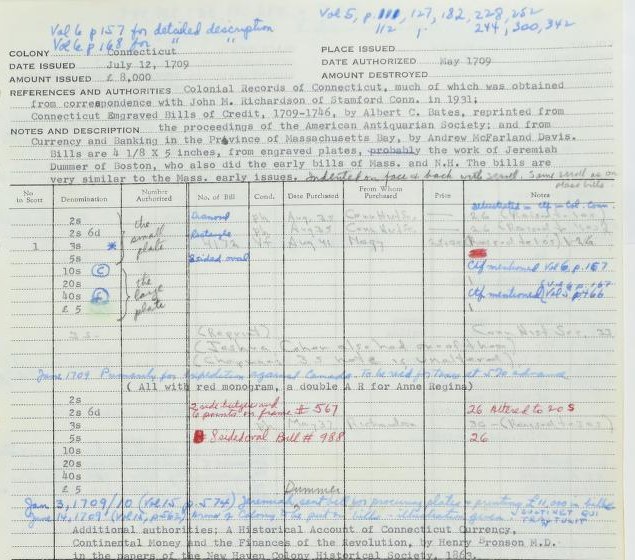
Freeman-Newman worksheet for the July 12, 1709 Connecticut bills of credit
Link to Heritage sale:
http://currency.ha.com/itm/colonial-notes/connecticut/colony-of-connecticut-july-12-1709-3-shillings-raised-to-10-shillings-fr-ct-3a-pcgs-very-fine-30-apparent/a/3539-18024.s
Link to Harley Freeman inventory on NNP:
https://nnp.wustl.edu/library/book/520762?page=174

ANA OFFERS MARCH 2018 GRADING COURSES
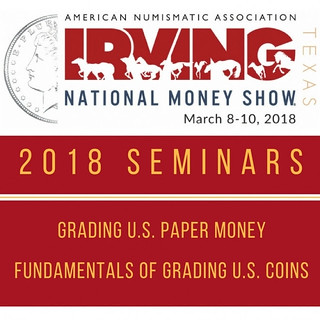 The ANA is offering two educational courses in conjunction with the 2018 National Money Show in Irving, Texas.
The ANA is offering two educational courses in conjunction with the 2018 National Money Show in Irving, Texas.
Fundamentals of Grading U.S. Coins and Grading U.S. Paper Money will be offered prior to the 2018 National Money Show, which starts Mar. 8.
Register before Jan. 19, 2018 to receive a $25 early enrollment discount. ANA Life Members receive an additional $40 discount!
GRADING U.S. PAPER MONEY
This hands-on seminar focuses on introductory and intermediate grading skills across a number of popular paper money areas. There also will be opportunity for group discussion and one-on-one instruction. Students are encouraged to bring up to 10 of their own notes for grading, as well as a magnifying loupe.
Instructor : Glen Jorde, professional numismatist, Lake Region Coin and Currency; former manager of Paper Money Guaranty (PMG); and past president of the Professional Currency Dealers
Association
Date & Time : 9 a.m. to 3 p.m., Tuesday-Wednesday, Mar. 6-7, 2018
Tuition: $259 for ANA members. Register by Jan. 19, 2018 for a $25 early enrollment discount. Take another $40 off if you’re an ANA Life Member!
FUNDAMENTAL OF GRADING U.S. COINS
 Sharpen your grading skills! Knowledge of coin grading not only makes you more confident on the bourse floor, but also adds to your enjoyment of the hobby by helping take the worry out of
numismatic purchases. Learn how U.S. coins should be graded according to the latest ANA and market standards.
Sharpen your grading skills! Knowledge of coin grading not only makes you more confident on the bourse floor, but also adds to your enjoyment of the hobby by helping take the worry out of
numismatic purchases. Learn how U.S. coins should be graded according to the latest ANA and market standards.
The seminar covers many topics and emphasizes the fundamental principles of grading circulated U.S. coins, including the history and evolution of grading standards, analysis of a coin's focal points, technical and market grading, how to determine initial signs of wear and evaluating surface marks, strike, luster and eye appeal.
Instructors : Rod Gillis, ANA education director; and Sam Gelberd, ANA numismatic educator
Date & Time : 9 a.m. to 5 p.m. Tuesday-Wednesday, Mar. 6-7, 2018
Tuition : $259 for ANA members. Register by Jan. 19, 2018 for a $25 early enrollment discount. Take another $40 off if you're an ANA Life Member!
To register, see:
Register for National Money Show Seminars (https://www.money.org/NMS-seminars)
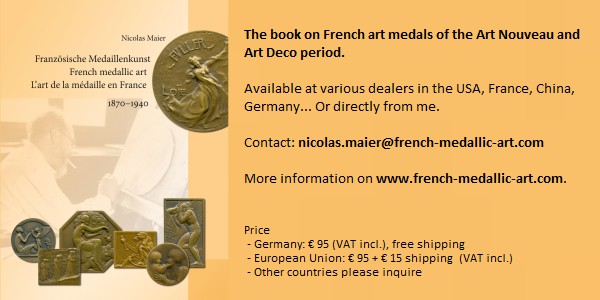
QUERIES: PICASSO AND ROYAL TOUCH GOLD COINS
Picasso Commemorative Gold Coin
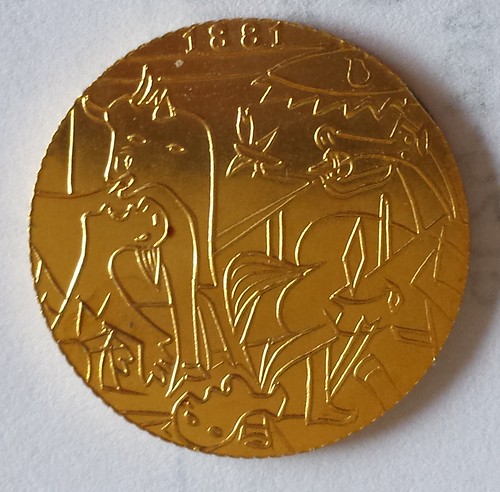

I have a Picasso gold coin commemorating 100 years since his birth. Are you familiar with this? Is it worth anything more than melt?
Royal Touch Coins
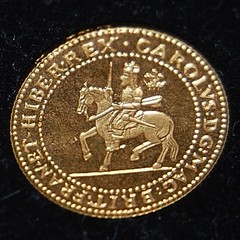

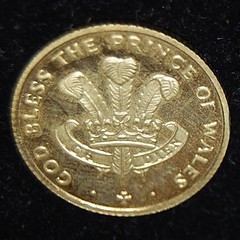

With the same purchase I bought some gold “Royal touch coins.” can’t find anything on internet about them either. I guess some company makes a coin and then Queen Liz touches them to make them worth more. Great idea for Home Shopping Network ;)
The Royal is when Diana married Charles, The Prince is for Prince William's christening.
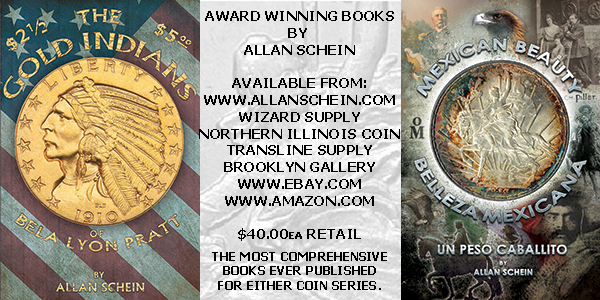
NOTES FROM E-SYLUM READERS: NOVEMBER 19, 2017
More on on Wladyslaw Terlecki
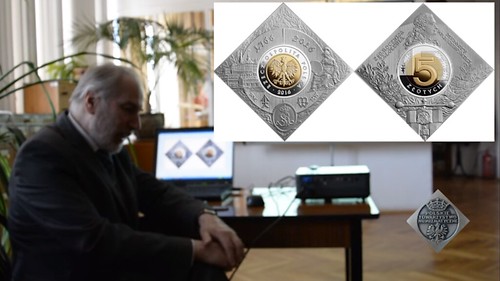
Tomasz Bylicki lecture
What a coincidence! Not knowing that the most recent issue of The E-Sylum had a piece on Wladyslaw Terlecki, I happened to listen Monday morning to a lecture in which Terlecki’s name was mentioned.
Tomasz Bylicki’s lecture was given at the meeting of the Polish Numismatic Association in Lodz last year. It was about the history of the Polish Mint (very informative though only available in Polish).
It is no wonder that Terlecki was mentioned in Bylicki’s talk. Wladyslaw Terlecki was not only one of Mint’s directors (1945-1946), but also a curator of its Coin Cabinet from 1927 to 1940. His famous rescue of the Mint’s collection included not only the gold bars, but also the Mint’s numismatic collection: coins and medals produced in the Mint, and the collection of Roman, Greek and Polish coins collected by his father, also named Wladyslaw Terlecki, physician and numismatist.
After WWII the collection of 3,500 items was deposited in the National Museum where it is held today. Terlecki was honored with a medal commemorating his rescue effort:
To watch the complete lecture on YouTube, see:
250 lat Mennicy Warszawskiej (https://www.youtube.com/watch?v=_tUFocxIgQc)
For the coin commemorating Wladyslaw Terlecki, see:
Klipa Wladyslaw Terlecki z serii "Historia Mennicy Warszawskiej" zloto
(https://www.emonety.pl/product/3217_klipa-wladyslaw-terlecki-z-serii-historia-mennicy-warszawskiej-zloto)
Query: Krueger 1986 Spring Sale PRL Sought
Gregg Silvis writes:
Just wondering if anyone might have a Prices Realized List for the 1986 Spring Americana/Exonumia auction by Kurt Krueger. In particular, I am interested in lot 3138 - 1792 British Token C/M: M. Bryan, VF. I happened to acquire this piece, with the remnants of the ticket from this auction, on eBay. I continue to be amazed at what one can find on there. Thanks!
Ford Sales Catalogs Sought
Darryl Atchison of County Cork Ireland writes:
I am desperately looking for copies of the John J. Ford Jr. collection catalogues for parts XXII, XXIII and XXIV. Anyone who has copies of these catalogues can contact me directly by email at atchisondf@gmail.com.
Query: C. C. Wright
Flickr visitor AAAndrew writes:
I am researching the steel pen business of C. C. Wright and was wondering if you have any more ephemera from that un-studied part of his work? Thanks!
More on "Hot Shortness"

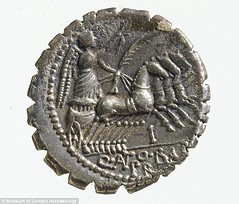
Eric Schena writes:
I saw the definition for "hot shortness" in the latest issue of The E-Sylum and wanted to comment on it. I am not so sure the illustrated coin - a serrate Roman Republican denarius - would be the best illustrative example for that definition. There are several issues of denarii from the Roman Republic that were intentionally serrated, thought to have been hand done with a chisel. The purpose of this has been debated, either as a way to prevent clipping (a very early form of edge reeding) or as a way to expose the content of the coin as silver and not plated. This process was not consistent across all moneyers and was no doubt quite time consuming to do, but when it was employed, the entire issue would be serrated.
There are also some Seleukid bronze coins that look more like bottlecaps and are also called serrate, though the purpose there is quite unclear and the manufacture technique was certainly different.
If the definition of hot shortness is based on it being a side effect of inconsistent metal composition causing those flan cracks and fissures, serrate denarii would not precisely fit that definition. I have seen some denarii of the Severan dynasty when there was debasement that suffered from hot shortness, as an example.
To read the earlier E-Sylum article, see:
VOCABULARY TERM: HOT SHORTNESS (http://www.coinbooks.org/v20/esylum_v20n46a15.html)
More on the U.S. Mint Numismatic Library
Dave Lange writes:
As always, I enjoyed last week's issue. Thanks for bringing us all such a good read.
Regarding the U. S. Mint's Library that seems to have gone missing, I have something to add. When I lived in the San Francisco area, I did much of the research for my early books at the Old San Francisco Mint Museum, now closed to the public. It had a large and splendid room that was entirely dedicated to a numismatic library. This possessed all of the standard references that most of us would have had in our own libraries during the 1980s-90s, as well as a nearly complete set of U. S. Mint Director's reports in original, matching bindings. There were few unique items or primary source documents, and those that existed did not relate to United States coinage, but rather to western history, yet I was able to make great use of it at no cost to me.
When I first started going there, an employee was assigned to sit in the room with me for security purposes (this was long before 9/11, so the primary security concern was theft). After I'd been there a few times, they left me alone, and I had the run of the place. When the OSFMM, closed (first, temporarily in 1993, and then for good a year later), the library was removed. I don't know exactly where the books and documents went, but I was told it was somewhere in Washington.
To read the earlier E-Sylum article, see:
NOTES FROM E-SYLUM READERS: NOVEMBER 12, 2017 : Query: U.S. Mint Numismatic Library
(http://www.coinbooks.org/v20/esylum_v20n46a12.html)
Albums For Coins of Palestine
Dave Lange adds:
I also took note of the album for coins of Palestine. It's not possible to see much in the photos, but I recognized it as one I have in my collection of coin albums. It was custom produced by Dansco for R. P. Nielsen in the 1970s. There is no reference to Dansco, but instead it is marked "Nielsen-Porter, Inc., Houston, Texas." A publisher number of P-100 is also included.
There is a second album by and for the same parties titled "ISRAEL AGOROT-POUND SERIES II 1969-1975," and this is publisher number I-110. These albums were produced a few years after Whitman had printed the first two albums in the series, I-100: "ISRAEL AGOROT-POUND SERIES I 1960-1968," and I-200: 'ISRAEL COMMEMORATIVES VOLUME I." Both of these were custom printed in Whitman's "Bookshelf" album format of 1961-77 and were published by the "R. P. NIELSEN COMPANY," with no mention of Porter or Whitman.
I don't know why Dansco was chosen over Whitman for the two later emissions, but they did appear right about the time that Whitman was phasing out its Bookshelf line in favor of the still-current "Classic" line. Another possibility is that Nielsen and Porter went with Dansco because their custom titles may have complimented Dansco's own standard albums for "Israel Type" (7600) and "Israel 1948-1957" (7601), which held all coins by denomination and date.
All of the above-mentioned albums are long out-of-print and quite scarce. The two standard Dansco albums bring strong money in the secondary market, yet the Nielsen albums don't attract much attention. They are by far the rarest of the lot and should be worth more, but potential buyers perhaps are turned off by the lack of a brand name. For any collectors who may be seeking an album for coins of Palestine during the British Mandate, a current line of albums by Arabiancoins.com that is comparable to Dansco in quality includes this title: http://www.arabiancoins.com/index.php?main_page=index&cPath=33&zenid=snacdcmp2dmuu2s2v3p8uk0ee1
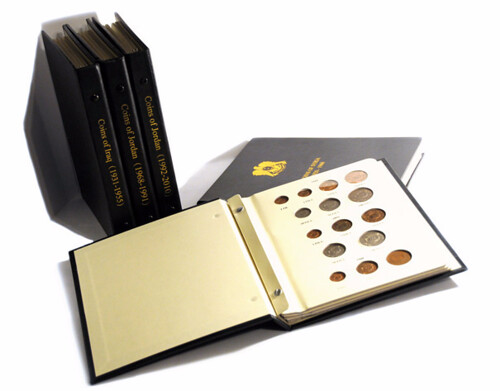
To read the earlier E-Sylum article, see:
ARCHIVES INTERNATIONAL SALE 45 : Lot 632: Palestine Mandate Album, 1927-1946 (http://www.coinbooks.org/v20/esylum_v20n46a20.html)
Ice Cream Shop Floor Paved in Cents

Larry Dziubek writes:
I thought readers would like this after seeing the Lincoln head artwork in last week's issue. A friend saw this floor in Grand Pa Joe's Candy & Ice cream shop, located at 2124 Penn Ave, Pittsburgh, PA (in the Strip District). It's all pennies.
To read the earlier E-Sylum article, see:
RICHARD SCHLATTER’S 'A. LINCOLN' PORTRAIT (http://www.coinbooks.org/v20/
esylum_v20n46a29.html)
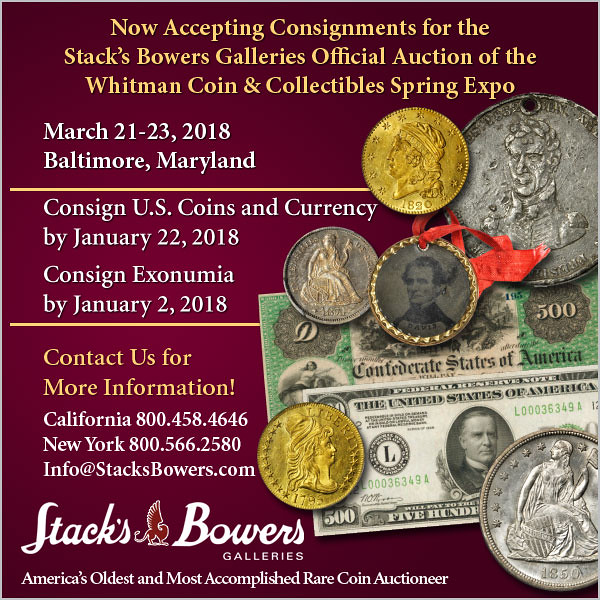
VOCABULARY TERMS: ONE LINERS
One Liners
Applied Ornament. Applied work. See applique.
CLASS 09.05
Assurgent. Rising from the sea. See ascendant.
CLASS 11.4
Bail. A minute ring for suspending medallic or jewelry items. See loop.
CLASS 10.6
Box Die. A British term for open face die.
CLASS 04.4
Broad Flan. Struck on a planchet of greater diameter than usual. See oversize flan.
CLASS 06.9
Chip. A tiny portion of a die broken away from the die’s surface. See diechip.
CLASS 06.9
Choice. A collectors’ term for a selected specimen; one of exceptional condition.
CLASS 13.3
Cire-perdue. French word for the lost-wax process of casting. See precision casting.
CLASS 07.2
DES. Abbreviation for designer, the artist who prepares a coin or medal design.
CLASS 03.6
Die Line. The outermost design limits on the face of a die.
CLASS 04.4
Ding. A collectors’ term for a nick or small gouge.
CLASS 13.3
Disk. (2) A blank in circular shape; a planchet.
CLASS 06.2
Double Legend. Two lines of legend.
CLASS 02.10
EGP. Electro goldplate; gilt.
CLASS 09.7
Emblem Die. A small die, particularly for striking emblems.
CLASS 04.4
Enameler. A craftsman who applies and bakes enamel.
CLASS 09.6
Engrave. To cut into metal; to cut a die.
CLASS 04.1
Face. (2) The obverse of a numismatic item.
CLASS 11.4
Foliated Edge. An engrailed edge of leafy decoration.
CLASS 02.7
FS. Fine silver, often appearing after a number, as 999 FS.
CLASS 05.
Incise. To cut or engrave into a surface.
CLASS 04.1
Indented. (2) British term for incised lettering, particularly edge lettering.
CLASS 10.2 k
Knock. A collectors’ term for an edge nick.
CLASS 13.3
Mercury Gilding. Another term for firegilding. See firegilding.
CLASS 09.7
Mint Frost. Mint luster or mint bloom still on a freshly struck coin.
CLASS 06.7
Modular Dies. A collectors’ term for insert dies.
CLASS 04.4
Mute. Without lettering; anepigraphic.
CLASS 02.10
NS. Abbreviation for nickel-silver.
CLASS 05.4
Overchased. An excessive amount of chasing; spoiled by tooling.
CLASS 08.9
Pedigree. The record of previous owners of a valuable item. See provenance.
CLASS 11.4
Piece. A single item, an individual numismatic specimen.
CLASS 11.4
Profile. (2) The shape of a die. See dies and diemaking.
CLASS 04.4
Proofing. A testing of the die. See proving.
CLASS 04.7
Remedy. A British term for tolerance.
CLASS 05.2
Resist. A British term for a resistant or stop-off.
CLASS 09.1
Service Pin Die. A small die for striking a service pin; an emblem die.
CLASS 04.4
Specimen. (2) An individual numismatic object, otherwise called an item or piece.
CLASS 11.4
Struck-thru. A collector’s term for impressed error.
CLASS 13.3
Tipped Die. Incorrect seating of a die. See misaligned die.
CLASS 06.9
Transfer Engraver. A person who operates a transfer lathe or pantograph.
CLASS 04.6
Verso. The reverse of a coin or medal.
CLASS 11.
Wax Modeler. A person who prepares a bas-relief model in wax.
CLASS 03.4
Looking for the meaning of a numismatic word, or the description of a term? Try the Newman Numismatic Portal's Numismatic Dictionary at: https://nnp.wustl.edu/library/dictionary
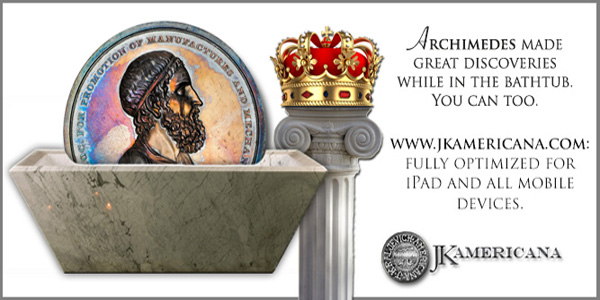
HERBERT ELLIS MOREY (1848-1925)
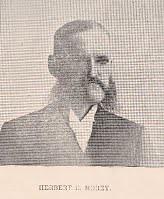 Herbert Ellis Morey (1848-1925), was born April 21, 1848 to the most affluent family at “Morey House,” Malden, Massachusetts. His parents were very active abolitionists working with William
Lloyd Garrison and Wendell Philips, and they used their home as one of the stations of the Underground Railroad affording slaves safe passage to Canada. Many slaves were secreted from the Morey home
to that of Harriet Beecher Stowe at Andover. His maternal grandfather, Timothy Bailey was the president of Malden Bank.
Herbert Ellis Morey (1848-1925), was born April 21, 1848 to the most affluent family at “Morey House,” Malden, Massachusetts. His parents were very active abolitionists working with William
Lloyd Garrison and Wendell Philips, and they used their home as one of the stations of the Underground Railroad affording slaves safe passage to Canada. Many slaves were secreted from the Morey home
to that of Harriet Beecher Stowe at Andover. His maternal grandfather, Timothy Bailey was the president of Malden Bank.
He graduated Malden High School in 1866. He then graduated from the Massachusetts Agricultural College in 1872. He was the first baseball captain of the first baseball team ever at Massachusetts Agricultural College. Later on in life his son David Beale Morey will be a famous baseball player at Dartmouth College, at Worcester for the New England League and Middlebury. If Morey had been born a a few years earlier he might have been one of the first professional baseball players in the National League rather than a businessman and coin dealer.
He was employed at Morey, Smith & Co., merchants, at Boston, 1872-1881.
On August 11, 1874 he married Ellen "Nellie" A. Beale (1850-1931), an accomplished musician and music composer and neighbor at Malden, Massachusetts, at the Congregational Church at Orfordville, New Hampshire. Years after their marriage his wife became a cause célèbre in music and was known as Mme. Beale-Morey. She gave recital tours throughout Europe for several years.
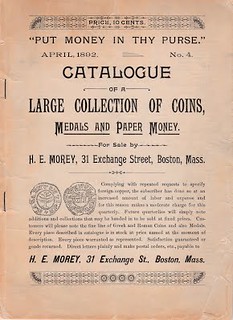 In 1881 he became a member of the firm at Morey, Smith & Co. They had one son and two daughters. His residences : 49 Haverhill Street, Boston, Massachusetts, and 34 Hillside Avenue, Malden.
Business : Room 1, 31 Exchange Street, Boston, Massachusetts, formerly of Malden, Massachusetts. Moved to 41 Washington Street, Boston, Massachusetts. He styled himself as a numismatist and
philatelist dealing in ancient Roman, foreign and American coins, medals, paper money and postage stamps. At one time he was offered the position of the curator of the U. S. Mint at Philadelphia but
refused it due to increasing deafness and not willing to leave his home state.
In 1881 he became a member of the firm at Morey, Smith & Co. They had one son and two daughters. His residences : 49 Haverhill Street, Boston, Massachusetts, and 34 Hillside Avenue, Malden.
Business : Room 1, 31 Exchange Street, Boston, Massachusetts, formerly of Malden, Massachusetts. Moved to 41 Washington Street, Boston, Massachusetts. He styled himself as a numismatist and
philatelist dealing in ancient Roman, foreign and American coins, medals, paper money and postage stamps. At one time he was offered the position of the curator of the U. S. Mint at Philadelphia but
refused it due to increasing deafness and not willing to leave his home state.
He became a collector as a schoolboy of about eight or nine circa 1857, though his obituary claims since the age of 10, i.e., 1858. Regardless, about thirty-two years later he began as a part-time coin and stamp dealer in 1889. He was married and worked as a bookkeeper until 1890 when he became a full-time coin dealer issuing his first fixed price catalogue serving also as his numismatic auction mail bids catalogue and published ads in The Numismatist. He applied for membership to the ANA in 1891 and is ANA charter member No. 61.
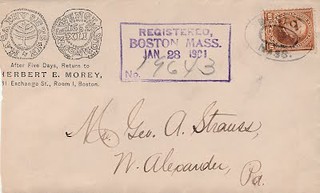
"Mr. H. E. Morey was found by us when last in Boston in a narrow winding street of that city's busiest and most labyrinthine section, in an office on the second floor. A counter and showcase full of coins protected him from the class of people who want to know the premium on V nickels and '53 quarters with rays, and a big fireproof contained stock for a higher class of visitors. There was a little inner room also for retreat and possibly editorial labor, as Mr. Morey issues a little sheet called the Numismatic Quarterly and Catalogue. He is a middle-aged rather quiet man wearing spectacles and has the air of a schoolmaster.”
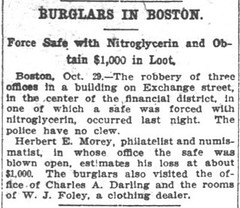 In 1905 he held 12 mail bid coin auction sales, with May having two sales, since there was no sale in February, making that year his fourth largest number of mail bid sales held in a single
year in his career.
In 1905 he held 12 mail bid coin auction sales, with May having two sales, since there was no sale in February, making that year his fourth largest number of mail bid sales held in a single
year in his career.
He died on Sunday evening on March 22, 1925 at his home. He never missed a National League baseball game held at Boston. Oddly enough the June 1925 issue of The Numismatist listed Herbert E. Morey as an advertised coin dealer three months after his demise.
To read the complete article, see:
MOREY, HERBERT ELLIS
(https://sites.google.com/a/numismaticmall.com/www/numismaticmall-com/morey-herbert-ellis)
The entire inventory of the Lupia Numismatic Library is for sale. Individual items will be available before the remaining archives are broken up into parcels sold at philatelic auctions in the U. S. and Hong Kong. Check NumismaticMall.com frequently as dozens of new items with estimates will be posted daily until everything is sold.
All inquiries will be given prompt and courteous attention. Write to: john@numismaticmall.com .
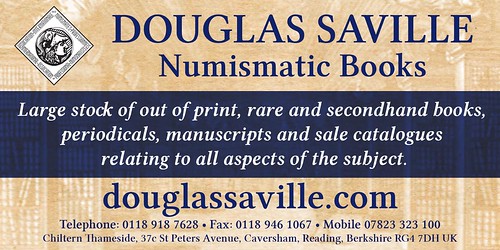
HARVEY STACK'S NUMISMATIC FAMILY, PART 5
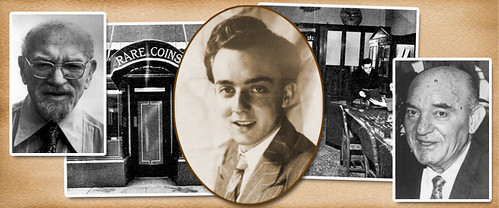
My uncle, Joseph B. Stack, had two sons, Benjamin and Norman. They were my first cousins and like me they were constant visitors to our store on 6th Avenue. In age Benjamin was the oldest, although he was less than two years older than Norman who was 19 days younger than me. We kidded with Norman, calling him the Young Stack.
Typically, as Ben was the oldest, he thought he should be the one in charge and dole out the assignments that we were given. These tasks included sweeping the floors, washing the front window, polishing the glass on the showcase, taking out the trash, and so on. Ben did only the important jobs while Norman and I were given the less popular jobs.
A major event that I remember from the early 1940s was the acquisition of the George Clapp Collection. Clapp was from Washington, DC and had one of the nation's most complete collections of United States coins, with many of the coins in outstanding condition. Mr. Clapp bought Proof coins directly from the Mint each year, 1880 to 1915, so they were of the highest quality.
During this time period, my father and uncle were working with a collector from Baltimore, Louis E. Eliasberg. We suggested to Mr. Eliasberg that he consider buying the Clapp Collection intact, as it would be a great help in achieving his goal: owning one each of every United States coin. The deal was made and the Clapp Collection coins became part of the incredible collection of Louis E. Eliasberg, staying with him for decades. The Eliasberg Collection remained intact and was not sold until the 1980s and 1990s, after that gentleman's death.
This deal was a truly major numismatic event. Nothing like this had ever happened before. And since the Eliasberg Collection has been dispersed to new collectors it will likely never happen again.
As youngsters we were lucky to be around when this happened. One day when we were there doing chores we were all introduced to Mr. Eliasberg. Later visitors often asked us what it was like to be around for such a historical event and we were always happy to tell about meeting this fine collector and witnessing such a monumental transaction.
Louis E. Eliasberg was but one of the great collectors of the 1940s that my cousins and I met, and sometimes helped out in one way or another. Some other famous numismatists included John Jay Pittman, Martin Kortjohn (of ANA fame), and numerous collectors whose names and collections would become very important as the hobby expanded in the middle of the 20th century.
Unfortunately, during the 1940s World War II had broken out, and a number of our friends and colleagues entered the Armed Services. Included in this group were John J. Ford, Jr. (a young and promising numismatist), Cornelius Vermeule (a great student of the classics who later was curator of the Boston Museum of Fine Arts), Henry Grunthal, (later the curator of the American Numismatic Society) and others who are legendary in the halls of numismatics. Ben, Norman and I were still in school and had education deferments.
To staff the store we still had specialists like James C Risk (until he became the United States naval attaché to Russia), Hans Holzer (who was deferred because of health), and Edward May who was too old to serve. However, there was a need for more professional staff. In order to be as useful as possible, it was important for Ben, Norman and I to gain as much knowledge as we could. So we spent virtually all of our spare time and school vacations helping out in the shop. We were lucky to have this opportunity, as during this time period we learned a lot about numismatics from our parents as well as from the collectors who came to the store and shared their great knowledge with us.
To read the complete article, see:
Growing up in a Numismatic Family Part 5 (http://www.stacksbowers.com/News/Pages/Blogs.aspx?ArticleID=2746)
To read the earlier E-Sylum article, see:
HARVEY STACK'S NUMISMATIC FAMILY, PART 4 (http://www.coinbooks.org/v20/esylum_v20n45a25.html)
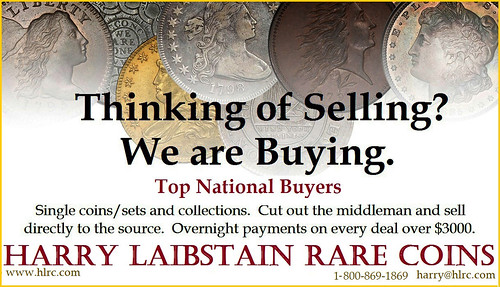
MORE ON LIFE OF ERIC P. NEWMAN
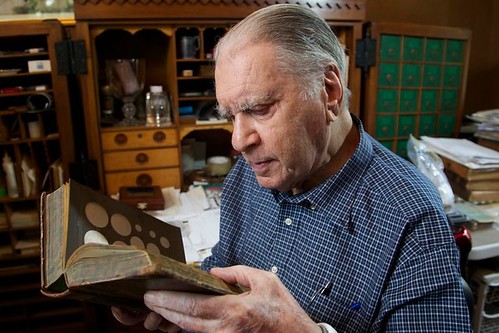
It was just a strange old penny, a copper-nickel Indian Head minted in 1859, when the government was trying out different metals for one-cent pieces. A grandfather gave it to Eric Pfeiffer Newman in 1918, when he was 7, a little bonus for his nickel-a-week allowance.
For almost a century, Mr. Newman called the fascinating old penny his first numismatic inspiration, a doorway to the past that took a boy from St. Louis into a life of curiosity, travel and adventure and made him one of America’s most distinguished authorities on the art and history of coinage and paper money.
He went on to scour the United States and visit more than 150 countries to explore the relationships between money and the societies and cultures it served. He died on Wednesday at his home just outside St. Louis, in Clayton, Mo., where he had lived all his life. He was 106.
To anyone who imagines that numismatists are hopeless romantics searching for coins in shipwrecks, musty attics and old curiosity shops, Mr. Newman was a composite antithesis: the author of books and scholarly articles and a consummate intellectual with an encyclopedic memory, a passion for history, the instincts of a relentless detective and the sharp eye of a trader in antiquarian treasures.
He tracked down promissory notes issued by a wealthy Philadelphian that had secured his place in history as a major financier of the Revolutionary War and the national government in its fragile early days. He found 19th-century American gold and silver coins that matched French and Italian weights, and deduced that they were prototypes for a trans-Atlantic currency, a kind of Eurodollar that never succeeded.
He discovered Ohio and Connecticut bank notes engraved with what were almost certainly John James Audubon’s earliest published illustrations of a bird: a meek little grouse, circa 1824, several years before the appearance of the first plates in his masterpiece ornithological portfolio, “The Birds of America.”
He documented Benjamin Franklin’s central role in developing American currency by printing intricate leaf patterns to foil counterfeiters in the 1730s. He studied African-American influences on the nation’s money, notably that of Blanche Kelso Bruce, a former slave whose signature as Register of the Treasury appeared on all United States currency from 1881 to 1885, under Presidents James A. Garfield and Chester A. Arthur, and from 1897 to 1898, under President William McKinley.
He wrote books on fakes: “The Fantastic 1804 Dollar” (1962, with Kenneth E. Bressett), about a coin actually struck in 1834 to make diplomatic gifts, and “The Secret of the Good Samaritan Shilling” (1959), about a bogus 1652 Massachusetts coin exposed by Mr. Newman as a 1750s imitation. In his dry wit, he called it “a muled restrike of a reproduction of an erroneous drawing, copied from a conjured illustration of a genuine coin.”
To read the complete New York Times article, see:
Eric Newman, Whose Coins Told of America’s History, Dies at 106
(https://www.nytimes.com/2017/11/16/obituaries/eric-newman-dead-leading-authority-on-coins.html)
The article is still an excellent one, doing a fine job of capturing the essence of its subject. Be sure to read the complete version online. -Editor
Pablo Hoffman writes:
A few words on reporter Robert D. McFadden of New York Times, the winner of the Pulitzer Prize for “Spot News Reporting, 1996:, "for his highly skilled writing and reporting on deadline during the year."
He is known throughout the world of journalism for his many professional accolades, and for his well-written obituaries of notables, including Eric Newman’s.
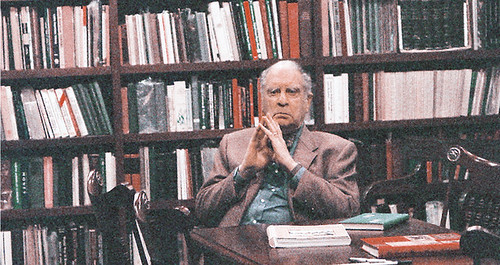
Renowned numismatist Eric P. Newman, who once owned all five examples of the 1913 Liberty Head 5-cent coin at the same time, died the afternoon of Nov. 15 at age 106.
News of Mr. Newman's passing was communicated to the coin community by Leonard Augsburger, who is project coordinator for the Newman Numismatic Portal at Washington University in St. Louis.
Net proceeds from the sales by Heritage Auctions, beginning in 2013, of select material from Newman's extensive numismatic collection (amassed over more than nine decades) has funded the numismatic research portal and other philanthropic endeavors, via the Eric P. Newman Numismatic Education Society. The Heritage sales have comprised material from early U.S. numismatics, including coins, paper money and patterns.
Heritage’s most recent sale Nov. 3 of Newman's holdings included one of just four known examples of the 1861 Confederate States of America half dollar. Graded Proof 40 by Numismatic Guaranty Corp., the coin realized $960,000. The sale was its first public appearance at auction, as it had been off the market since Newman purchased it for $4,000 from the estate of Col. E.H.R. Green nearly 80 years ago.
To read the complete article, see:
Eric P. Newman, numismatist extraordinaire, dies at age 106
(https://www.coinworld.com/news/us-coins/2017/11/numismatist-eric-newman-dies-at-age-106.html)
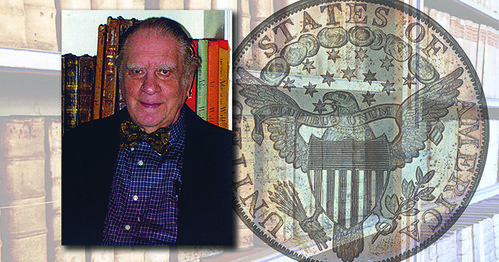
When I started working at Whitman Publishing in 2004, Eric P. Newman was already long established in many fields, including numismatics. He was in his early 90s at the time and going strong.
A few memories:
My first communication with Mr. Newman started in 2005, after he read an early draft of Q. David Bowers’s manuscript for what would become the Guide Book of Shield and Liberty Head Nickels. To say that his comments, edits, and recommendations were sharp would be an understatement. They were razor-sharp, gently but firmly communicated, full of wit, precision, and clarity. “Authoritative” is the word. He pointed out statements that were conjectural. He advised where clarification was needed. He corrected seemingly minute but actually significant errors of fact. He offered changes in wording to make the already strong text even stronger.
At the time Dave’s ~150-page manuscript was just one of several that Mr. Newman was editing for other researchers. “Keep writing and keep numismatics hopping,” he told his longtime friend. Who else but Eric P. Newman could advise Dave Bowers thus!
In December of that year Mr. Newman emailed Dave and several Whitman associates to clarify the dates of the Massachusetts colonial paper-money issues of 1690 and 1691—a complex subject that he explained with his usual authority and clarity. (His explanation would be folded into the manuscript for 100 Greatest American Currency Notes.) In this email, the elder statesman of numismatics illustrated his modesty and his approachable manner, inviting further questions and saying goodbye as “Eric to some of you and, for a little while, Eric P. Newman to the rest.”
It wasn’t long before he was signing off as just “Eric” in his personal correspondence to me. Why do I now refer to him as “Mr. Newman”? I need to work on that! He was always friendly and welcoming, and would undoubtedly laugh at the formality.
While his humor was fun and light-hearted, Mr. Newman’s scholarship always bore weight. In 2007 he offered important suggestions on the structure of Dave Bowers’s in-the-works Whitman Encyclopedia of Colonial and Early American Coins. He was a substantial guiding force in the book’s development, even from afar. Dave ended up dedicating the monumental book “to Eric P. Newman and his lifetime devotion to early American numismatics.”
In 2008 we started talking about crafting a new edition of a hobby classic, The Fantastic 1804 Dollar. Mr. Newman and Kenneth Bressett began working on that book in 1959. Ken was already known as a serious numismatist, though he wasn’t yet identified as “Mr. Red Book” (that title, at that time, was for R.S. Yeoman). The Fantastic 1804 Dollar was finally released in 1962, and the dramatic circumstances of its publication are the stuff of hobby legend. With the 50th anniversary of the start of their collaboration approaching, and with 1804 dollars constantly in the news, I wanted to create a new edition for today’s hobby community. It was an honor to work with Newman and Bressett on the “Tribute Edition” Whitman published in 2009, marking the 50th anniversary of the start of their writing on these famous coins.
Today Eric Newman may be gone, but he remains an active force in the hobby, art, and science of numismatics through the continuing work of his foundations, including the Eric P. Newman Numismatic Education Society (and its groundbreaking Newman Numismatic Portal), and of course through his voluminous published works, and the benchmarks he set for other researchers.
The great writer, who always considered himself a student, also kept up to date with Whitman’s publications. It was my honor to send him a copy of every new book as it was published, for his library. He read them all, and continued to take interest of all aspects of the field, as he did when he started in numismatics as a youth. “Keep producing books galore,” he once told me. And more advice to Dave Bowers: “Don’t stop writing. Don’t retire. And keep your mind churning, as always.”
I encourage every numismatist reading these words to continue Eric Newman’s legacy by taking that advice to heart.
To read the complete article, see:
A publisher’s memories of Eric P. Newman (http://news.coinupdate.com/a-publishers-memories-of-eric-p-newman/)
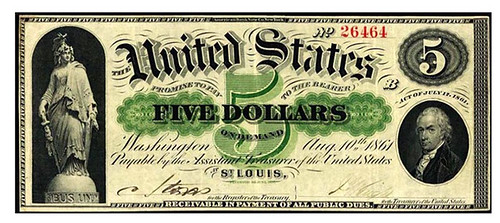
After Newman graduated from John Burroughs School, a private prep school in the suburbs of St. Louis, in 1928, he enrolled at the Massachusetts Institute of Technology (MIT). It was here that he met the legendary collector and Wall Street heir “Colonel” E. H. R. Green. As the story goes, Newman and some classmates were using a crystal shortwave radio to communicate with the expedition of Admiral Richard E. Byrd to the Antarctic but their equipment created a lot of static and frustration. When Col. Green found out about the problem his youthful numismatic friend was having, he gave Newman and his group free reign to use Green’s personal radio station based at Round Hill, Massachusetts.
And not only does this story speak to the power of numismatic camaraderie that we in the hobby are often lucky to know for ourselves, but Newman and his friends even managed to save the life of one of the expedition members who was suffering from appendicitis at the South Pole! Col. Green came to MIT to thank them all personally, obviously very impressed with his numismatist friend.
... in 1936, Colonel Green died. Familiar with his friend’s collection, Newman wanted to purchase a particular 1861 $5 St. Louis Demand Note but heard no response from Chase National Bank, the executor of Green’s estate. Newman wrote again, emphasizing his personal connection to Green. This time the bank replied, but only to tell him that he would have to buy all 40 lots of Missouri notes in the collection. Undeterred, Newman mustered up the $600 appraised value of the notes from his still very supportive family.
Upon this successful purchase, Newman told his mentor Burdette Johnson about it and the rest of the Green collection. Johnson then fronted Newman the cash to buy almost all of what remained – including the only five-known 1913 Liberty Head nickels. He let Newman keep whatever he wanted and took a selection of equal value for himself.
To read the complete article, see:
In Memoriam: The Life and Legacy of Eric P. Newman, 1911-2017
(https://coinweek.com/people-in-the-news/in-memoriam/memoriam-life-legacy-eric-p-newman-1911-2017/)
Over the last years, Heritage auctioned parts of his collection. The revenues were spent on the realization of what was the coin enthusiast’s vision: he wanted others to share his great passion. Eric P. Newman thus not only devoted the lion-share of his more than 100 books and articles to numismatic topics; Washington University has a Newman Money Museum, and the online available Newman Numismatic Portal offers a seemingly uncountable set of scans of numismatics sources that are otherwise hard to come by. The numismatic community needs people like Eric P. Newman. And it keeps bringing forth people like him.
After all, coin collecting is more than a short-term investment or an irrelevant pastime. It’s an attitude to life. It’s the lived conviction that we are part of a history to which we owe that we are who we are and which obliges us to pass the best we have and know on to future generations.
Eric P. Newman has lived this conviction. And for that, we are grateful to him.
To visit the Coinsweekly web site, see:
http://www.coinsweekly.com/
To read the complete article, see:
Renowned numismatist, polymath, and prolific writer Eric P. Newman
passes away at the age of 106 (http://news.coinupdate.com/renowned-numismatist-polymath-and-prolific-writer-eric-p-newman-passes-away-at-the-age-of-106/)
To read the E-Sylum special issue, see:
Volume 20, Number 47, November 15, 2017 (http://www.coinbooks.org/v20/club_nbs_esylum_v20n47.html)

MORE TRIBUTES TO ERIC P. NEWMAN
Maureen and Stu Levine write:
In his 1979 book, The Right Stuff, Tom Wolfe describes what qualities test pilots have that set them apart from others: an essentially unflappable nature combined with courage, nerve, tenacity, decisiveness, and precision. Combine those attributes with intelligence, honesty, generosity, humor, patience, curiosity, and kindness, and you might start to see a picture of Eric P. Newman.
Eric ushered in a new age of numismatic research and writing, dismissing anecdotes and relying only on facts obtained from careful observation, logical reasoning, and reliable sources. His words were chosen carefully, befitting a man trained in engineering and the law; they had to be just right, meaning exactly what he intended to express.
Always endeavoring to do the right thing, he methodically debunked fakery and fraud regardless of personal cost or friendships lost. Unearthing the truth was Eric’s main objective, and he perhaps initiated the first numismatic crowdsourcing request in 1959 when he wrote, “Can you help with your ideas, your data and information as to your [Machin’s Mills] coins?” He, in turn, consistently provided thoughtful, well-considered responses to the queries that increased exponentially over the years.
To those he mentored, Eric was generous, open-minded, patient, and critical in just the right way. He led by example, inspiring his collaborators to do their very best, and bringing a sense of wonder and excitement to every project. As a friend, he was thoughtful, clever, kind, funny, caring, appreciative, and gracious.
Eric definitely had “the right stuff,” and we treasure every moment he was in our lives.
Dick Johnson writes:
Eric Newman was America’s preeminent numismatist who left a large body of masterful work in his published books and articles.
A friend to all who met him, he shared his numismatic knowledge widely. I will long remember my conversations in his home when I was a college student in St, Louis. I was privileged to bestow him with his Gold Centennial Medal for the Rittenhouse Society on his 100th birthday. .
At that time I asked Eric to what he attributed his long life. His reply:
“Two things. Medicine and numismatics.”
He must have had the best doctors and kept his mind active with a life-long interest in numismatics.
He lived a long, eventful, fulfilling, satisfactory life. His reputation will last forever.
David Thomason Alexander writes:
Eric's death calls to mind an Egyptian tomb text. "This King Seti has escaped his day of death, this King Seti sails with the undying gods..." Someone it seemed would live forever, and actually does through his works!
Peter Bertram writes:
I was sadly not among those fortunate enough to have known, or even to have just meet, Mr. Newman. I did, however, know him well by reputation and his innumerable contributions to the numismatic community. We are all much poorer for his passing!
Rest in eternal peace, Mr. Eric P. Newman...............
Bruce Perdue writes:
Sorry to hear about Eric. It's a sad day for Numismatics.
John Lupia writes:
Eric is the Methuselah of American Numismatics. To use the Chartrain metaphorical adage Eric was a giant upon whose shoulders we sit aloft allowing us to see farther than those who came before us. He is sorely missed.
Dan Hamelberg writes:
To be sure, the old phrase "a gentleman and a scholar" would apply to Eric. We will miss him.
Clifford Mishler writes:
Eric was without question a unique individual. In our community there were none like him in the past. There will unlikely be any like him in the future. We have all been greatly enriched in our involvements by his presence during our passage. His knowledge, dedication, integrity, and support of the community were without parallel.
Jeff Starck writes:
Wow, Wednesday was tough. Kind of like, where were you when Kennedy was shot? Only for numismatists. Thanks for quick work on a special edition of The E-Sylum. The Newman Numismatic Portal (NNP) will live on as just one piece of Mr. Newman’s enormous legacy.
Anthony Terranova of New York City writes:
I'm going to miss my friend . He was a great inspiration for me. He made the numismatic world a terrific and learned place. I'm going to celebrate what he brought to it .
George Cuhaj writes:
Here is my photo of Eric with his granddaughter (who was a an ANS fundraiser for a time) and Arthur Houghton at the American Numismatic Society tribute held at the Explorer's Club in NYC some years ago.
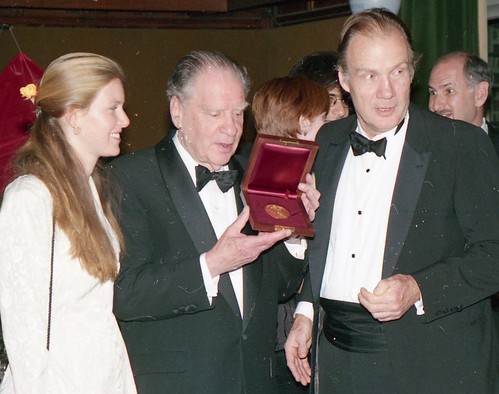
To read the earlier E-Sylum article, see:
TRIBUTES TO ERIC P. NEWMAN (http://www.coinbooks.org/v20/esylum_v20n47a03.html)

MORE ON ROBERT MARTIN AND THE MIDNIGHT SALE
David Menchell writes:
I read the latest comments about Robert Martin and thought I would add a few remembrances of my own. I first met Robert around the time of the Frederick Taylor sale in 1987. I was the new kid on the block with a recent interest in State coinage. Of course, I didn't have Robert's vast knowledge, but I guess I was active enough to come onto his radar. We soon began to communicate extensively.
Robert was something of a paradox: he had that New York accent and tough guy appearance that reminded me of Jack Palance, yet when he began talking about coins, he was very precise and methodical, not at all what you would expect. He maintained an extensive file on Connecticut coppers, which he willingly shared with anyone who was interested in the series. I remember his giving me lists of several Connecticut collections being auctioned taken from his notes, in advance of the actual auctions.
We would talk about the major sales, like Hessberg, Perkins and Ford, going over each lot, with Bobby highlighting those items he felt were underrated in terms of rarity, grading or condition census. If I purchased a piece that he was aware of, he would frequently provide me with pedigree information and the listings of prior auction appearances of the coin. He was a true connoisseur of the series. I can recall many a night when I would speak to him on the phone (usually later than 11) and we would be chatting away for two hours or more. I'm embarrassed to say that on more than one occasion I dozed off during these conversations, while Bobby was still enthusiastically continuing the discussion.
Bobby was a regular attendee at the first Colonial Cookouts that I held in the mid-1990's. These annual summer BBQ's at my home on Long Island were attended by many local collectors, including Bobby. He always brought items of interest to share with the rest of us. On one occasion, the evening was drawing to a close and the guests were leaving. Bobby was chatting with the late Steve Tanenbaum in front of the house. I had to run an errand and was away from the house for about two hours. I returned to find Bobby and Steve still chatting away exactly where I had left them two hours earlier.
Bobby always had interesting stories and anecdotes about himself and other collectors, usually told with a wry sense of humor. I remember his tale about his first wife and her disapproval of his interest in coins. "I was sitting at the kitchen table having breakfast and reading a copy of Coin World", he related, "when suddenly, a knife came plunging through the newspaper. I suspected at that time that she did not share my interest in coins".
Over time, family, career and other matters reduced my contact with Bobby. I would see him at Colonial coin gatherings and auctions, but he was always willing to talk and answer any numismatic questions. He was truly a unique individual, kind, knowledgeable, and generous in sharing his expertise with others. Numismatics has lost a brilliant and scholarly collector and researcher, and those of us who knew Robert Martin have lost a good friend.
David Fanning writes:
I was very saddened to hear of the death of Robert Martin. I probably met Robert about ten years ago at a C4 convention. I was collecting Connecticut coppers at the time and he was the acknowledged expert in that arcane little world (though he certainly would never have presented himself as so being).
Robert was kind and encouraging to his fellow collectors, and while he possessed the wit and intelligence to make him an insightful commentator on the foibles of our crowd, there was no malice in him. His willingness to share the knowledge he had carefully and laboriously built up over the decades is a model to be emulated. He'll be missed.
Here is a photo of Robert in the foreground at Roger Siboni's 2009 gathering of colonial coin collectors.

The Midnight Sale
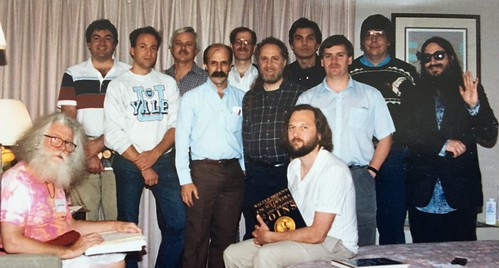
* Seated at left: Walter Breen
* Seated at right, holding book: Mike Ringo
* First row standing: Jeff Rock, Don Mituzas, Tom Rinaldo, Dave Townson, Michael Spencer
* Back row standing: Ed Sarrafian, Jim Goudge, Steve Tannenbaum, Robert Martin and Rob Retz
(Don Mituzas took the picture with a timer)
Don Mituzas writes:
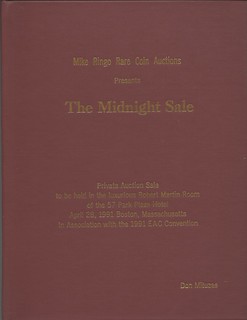 I was a friend of Robert Martin for more than 30 years. Randy Clark was nice enough to forward The E-Sylum to me with the tributes to Robert. At the end was a photo that I took of
the group present at the sale. I always had my camera with me at C4 conventions for coin photography. You had asked for more info on the sale so I thought I would respond.
I was a friend of Robert Martin for more than 30 years. Randy Clark was nice enough to forward The E-Sylum to me with the tributes to Robert. At the end was a photo that I took of
the group present at the sale. I always had my camera with me at C4 conventions for coin photography. You had asked for more info on the sale so I thought I would respond.
The impromptu sale was held in Robert Martin’s hotel room and was the result of a purchase of colonial coins that Mike Ringo had made. I’m quite sure that they came from the Worthy Coin Shop in Boston, but I’m not sure if they were part of the bid board they had at the time. Word got out that something was going on and a number of people showed up. Next thing you know Walter Breen was cataloging and creating lot tickets for the coins. Those in attendance were “registering” to bid and chose their own paddle number. Having a fondness for Machin’s Mills coinage I picked 9-76B for a rare Machins piece and Robert was 2.2-D.2 after a favorite 1786 Connecticut copper.
Walter Breen cataloged all the coins “lot tickets” on a small Howard Johnson’s note pad. Mike Ringo was of course the auctioneer. Bidding was active with most, if not all in attendance winning at least one lot. I think in many cases Walter’s hand written lot tickets are worth more than the coins. I still have the coins and lot tickets as a reminder of the event.
A couple of months later Rob Retz put together a hardcover auction sale catalog and sent it gratis to those who were part of the group. I believe he made a couple of extra copies, but I’m fairly certain the total printing was no more than 15 catalogs. The catalogs all had the owner’s name on the front cover. The Terms of Sale make me think of a SNL skit and that was the attitude in the room. It was really quite a fun and certainly memorable event.
As a side note Robert Martin and I frequently brought books that Walter Breen had written to the EAC conventions for his autograph. Usually it was more than an autograph. The Breen Encyclopedia Mike Ringo is holding is one of the books I brought for Walter to sign along with his book on US and Colonial Proof Coins. I’ve attached scans of those that were signed immediately after the sale in Walter’s classic purple pen.
RIP to those in the photo who are no longer with us including Walter Breen, Mike Ringo, Steve Tannenbaum, Rob Retz and most recently and of a great personal loss to me, Robert Martin.
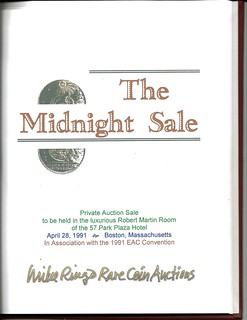
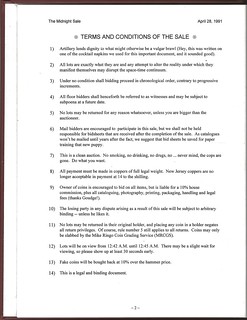
Title page and Terms of Sale

Lot Tickets
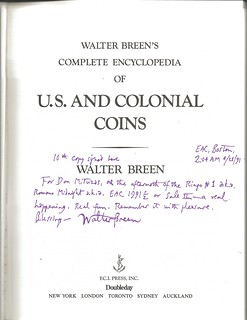
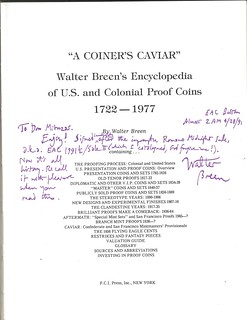
Walter Breen's Encyclopedia and U.S. Proof Coin books
Tom Rinaldo writes:
Before saying a few words about the sale itself I first want to pay personal tribute to Robert Martin. With only possibly the exception of Eric Newman, I have never known such a gentleman in our Colonial corner of numismatics as was Robert. Not that he was anyone's babe in the woods by any means. If there was ever dirt to be known about any players in Colonial coin collecting, Robert knew of it, but only because he cared so much about the hobby and was always paying very close attention. Maybe that informed the twinkle that was always in his eyes, but Robert remained kind and generous to all of us.
As the primary cataloger for the C4 Auctions for a dozen years I never could have remotely done justice to the Connecticut Coppers series in them were it not for Robert Martin. Come October I was always on the phone to him late at night, going over the best specimens of Connecticut Coppers consigned to each year's sale to try to fit them, best I could, into the general scheme of the condition census. And Robert was always ready with lot numbers of coins in sales gone by, stretching back for decades, that I should closely compare whatever coins that I called to talk to him about with, augmented by additional information he knew about from private holdings.
Robert didn't have to do that. He was after all still an active bidder on coins in those sales, but he never held back information. He always at the very least gave me leads. If I failed to adequately appreciate the implications of the clues that Robert always gave me, it wasn't because he ever attempted to mislead me. And the foundation of our hobby is that much stronger due to his generosity sharing that information.
The Midnight Sale itself was a total hoot. I no longer have my once personal copy of it - having long since sold it to a dedicated bibliophile friend who I knew would give it a fitting home. I can't remember what was actually said of it in the actual catalog, but I remember the motto: "Worth getting out of bed for". Mike Ringo had a bid in at a Boston coin shop bulletin board large lot of low grade coppers, which sure enough he won right before that C4 Convention in Boston. I believe it was Worthy Coins where he won it, but don't hold me to that - my memory is foggy.
Mike showed them to a few of us fellow colonial dealers and soon enough the idea of selling them all through a tongue in cheek auction in a hotel room was born. As those who have already seen the catalog know, large photos were taken, and later published, of some coins that almost anywhere else none would have thought worthy of even attributing. From start to finish it was organized in just hours. Walter Breen cataloged most of the lots on Hotel note pad paper, and Jeff Rock handled a few that Walter didn't get around to. I believe it was the last auction that Walter ever cataloged.
The rules for the auction emerged from a rowdy group session of suggestions, the wilder the better. Pretty quickly into the Sale itself all of us got bitten by the bug to actually buy something from the Midnight Sale, only because it was the Midnight Sale, not because we particularly wanted the actual coins we were bidding on. So the prices realized for lots were pretty crazy for what they were. But then again we all got copies of the catalog that was issued long after the sale itself was held. How unconsciously astute it was for all of us buyers, who no doubt lost money on any coins we purchased if we subsequently tried to resell them, to keep our makeshift paddles raised, for we all struck gold in the after sale catalog aftermarket. For that we all owe thanks to a true labor of love by Rob Retz, who compiled everything needed to turn a spontaneous numismatic happening into the splendid leather bound limited edition numismatic auction catalogs that are so coveted today.
My best wishes to all my good friends in one great hobby. And may Robert Martin always be remembered for the kind soul that he was, in addition to his being the master of Connecticut Coppers.
Jeff Rock writes:
Robert Martin was a dear friend for over 30 years and will be sadly missed. As one of the two cataloguers for this sale I feel like I can shed a little light on this event. The other cataloguer was none other than Walter Breen – a good friend and yet the only time we worked together on something numismatic. The auction catalogue from this sale is undoubtedly one of the rarest of the 20th century! But first some background.
In April, 1991 the EAC convention was held in Boston. The late Mike Ringo arrived a few days before us and scoured some of the local coin shops including one that had a bidboard (something sadly missed in the few remaining coin stores today). He bought several large groups of colonial coins, including a nice group of Connecticut coppers that had some better varieties in it – something he was famous for doing.
A group of us were in Robert Martin’s hotel room looking at them and attributing and at some point we said “let’s have an auction.” It was after midnight, but we ran around the hotel, waking people up to come join us. A dozen or so did, a few cussed us out for ruining their beauty sleep. While I have the original attendance list I think some people may not want to be publicly named – so I will just mention the ones in the photo who have passed away, which were Walter Breen, Rob Retz, Mike Ringo, Steve Tannenbaum and Robert Martin (in that order).
For the record, I am the baby in the room proudly wearing my Yale sweatshirt – I never attended that school, but had a friend who did and that was apparently justification for wearing it. We handed Walter some of the better coins and he wrote out descriptions on the Howard Johnson stationary at the hotel, and I did the rest, all while a haze floated above the room.
The fun continued both in the cataloguing and the terms and conditions of the sale that we wrote up as we went along, which included tidbits like “All payment must be made in coppers of full legal weight. New Jersey coppers are no longer acceptable at 14 to the shilling” and “All floor bidders shall henceforth be referred to as witnesses and may be subject to subpoena at a future date.” Snarky comments abounded in the footnotes (by this writer, after the sale itself was over, poking fun at just about everyone in colonials including himself) and they bring a chuckle to this day.
The sale did well enough, people took their coins and wandered to bed well after closing time at the local bars, and the matter was kind of forgotten (though we tried another sale the following year that was a dismal failure – magical moments seldom do well in a repeat performance).
As cataloguer I took the handwritten lot tickets with me, along with all the original documentation – and nothing happened. The group that was at the sale would wax nostalgic about it now and then, but it truly seemed like a different era just a few years after it happened.
 Now I didn’t say anything yet about the auction catalogue – because there wasn’t one at the time. But in a truly fitting fashion one was eventually issued – a half decade after the fact.
The late Rob Retz took it upon himself to complete the job, and I still had the handwritten material to work with. We were able to get photographs of some of the coins that the original owners still
had, as well as most of the lot tickets with written descriptions. A lavish hardbound catalogue was produced, with each individual’s name stamped on the cover – and as an added bonus a little pouch
was pasted in the inside back cover to hold those original lot tickets.
Now I didn’t say anything yet about the auction catalogue – because there wasn’t one at the time. But in a truly fitting fashion one was eventually issued – a half decade after the fact.
The late Rob Retz took it upon himself to complete the job, and I still had the handwritten material to work with. We were able to get photographs of some of the coins that the original owners still
had, as well as most of the lot tickets with written descriptions. A lavish hardbound catalogue was produced, with each individual’s name stamped on the cover – and as an added bonus a little pouch
was pasted in the inside back cover to hold those original lot tickets.
By the time the catalogue was produced Walter Breen had passed away, but all the other bidders received a copy and a couple more were produced for people who were at the hotel and should have been invited, one for Michael Hodder who was just starting his reign as the consummate auction cataloguer, as well as one that was sold for the benefit of The Colonial Coin Collectors Club (which I believe was Breen’s copy). Only a couple have appeared in the numismatic literature marketplace as their owners are rightfully proud of having been there, and I think only the Hodder, Retz and Ringo examples have been sold.
The total run was just 15 copies – and in a good democratic fashion there were no special editions produced – or rather, they were ALL special. Most bibliomaniacs haven’t heard of the sale since the majority are still held amongst the colonial collectors that were there in person. Eventually one might make it up on the Newman Numismatic Portal, but until then it may just remain the white whale of numismatic literature.
It's kind of sad to look at the photo and realize five out of the twelve have passed away, three are no longer that involved with numismatics and two are still collecting but haven't been to the C4 Convention in half a decade or more. Tempis Fugit....or, since we are colonial collectors, Fugio.
To read the earlier E-Sylum article, see:
ROBERT MARTIN (1946-2017) (http://www.coinbooks.org/v20/esylum_v20n46a07.html)

1792 SILVER AND NON-SILVER CENTER CENTS STUDY
Recently Rob Rodriguez, Tony Lopez, Maureen Levine and I completed a study on the Morris example of the 1792 silver center cent. The controversy regarding this coin came to our attention from the 2017 publication of 1792: Birth of a Nation's Coinage by Leonard Augsburger, Joel J. Orosz and Pete Smith. Here are some excerpts:
1792 Silver and Non-Silver Center Cents: A Study – Updated 11/15/2017
In 2017 authors Len Augsburger, Joel Orosz, and Pete Smith published 1792: Birth of a Nation's Coinage, in which they concluded that the Morris example of the silver center cent contains a silver plug that is not original (page 139).
Furthermore, on page 217 they cite the description from Chapman's 1905 sale of the Morris collection that states, "silver center inserted to give bullion value to this small size cent but the plug in this specimen has been inserted after the piece was struck and engraved with part impression."
We note that this part of the description from the April 19, 1905, Chapman catalog of the Morris collection more precisely states, "Silver center inserted to give bullion value to this small size cent but the plug in this specimen has been inserted after [Chapman’s emphasis] the piece was struck and engraved with part of hair and letters that should have been from the impression."
The description of the piece continues, “Two or three proofs in copper without the silver center are known, and this is one of these with the silver center falsely inserted.”
Below are images of the complete description from pages 32 and 33 of the 1905 Morris catalog:

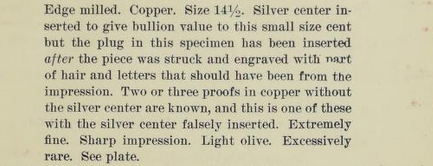
The purpose of this study is to compare the Morris example to the other known silver center cents and quantify any differences.
Silver Plug Diagnostics, Reverse:
On all 1792 silver center cents with silver plugs that have legible details on the reverse, the following have been observed:
1. The base of the E in CENT slants upward, toward the first upright of the N, except on the Morris example, on which the base of the E is slanted slightly downward toward the base of the N.
2. The thin upper serif on the crossbar of the E in CENT is attached to the topmost serif of the E. It is also noted that this same thin upper serif is attached perpendicularly to the crossbar. But on the Morris example, the serif attached to the crossbar does not join the topmost serif and is thick. Also, its inner portions are angled where attached to the crossbar
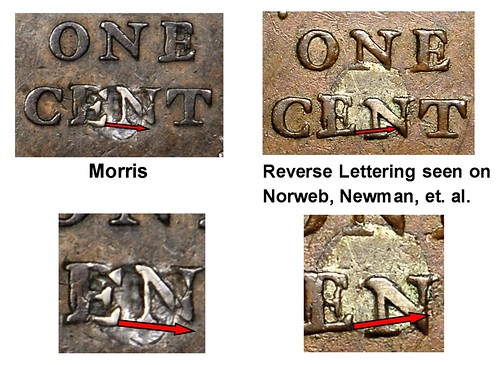
Silver Plug Diagnostics, Obverse:
On all 1792 silver center cents with silver plugs that have legible details on the obverse, the following have been observed:
1. The hair curls begin at the base of the earlobe.
2. On all, except the Morris example, the outermost curl is engraved in a wave-like shape that curves outward, inward, and outward again as it progresses lower.
On the Morris coin, within the silver plug, the inward curve is missing. The outermost hair curl is grossly misshapen.
The Morris plug also lacks the delineation of the inner curl (to the viewer's left of the outer curl).
Our final observation is that the Morris silver plug is smaller and placed much lower and more off-center than the plugs on all of the other examples
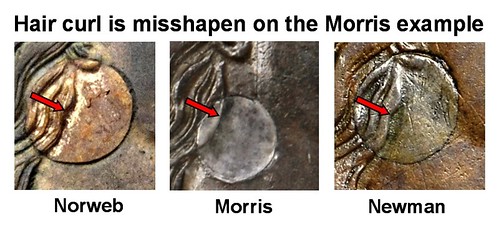



As shown in the above spreadsheet, the silver plug in the Morris silver center cent is the outlier in every column.
We concluded the following:
We wholeheartedly agree with the conclusions drawn by the authors, Len Augsburger, Joel Orosz, and Pete Smith on page 139, that "It is apparent that the Morris plug is not original with the [hair] curve out of position," and that the Morris plug's reverse shows a "tooled field and narrow tooled letters.”
It is our conclusion that the Morris example was produced at the Philadelphia mint as a genuine copper or fusible alloy Judd-2 1792 cent, or as a genuine so-called Judd-1A (a holed flan originally struck from 1792 silver center cent dies but without a silver plug) and at some later date (before April 1905) a “craftsman” fabricated a blank silver plug, punched or drilled (or, in the case of the so-called J-1A, widened) a hole into this genuine coin and inserted the plug. He or she then hand-engraved the plug on both obverse and reverse, in such a manner as to attempt to match the missing details and replicate an intact Judd-1 1792 silver center cent with a counterfeit plug.
The incentive clearly existed for a great profit to be realized upon the successful introduction of such a concoction into the numismatic market of the period: particularly if the fabricator started with a Judd-1 that was struck from a holed flan but without the silver plug as the example discovered in 1993 (the so-called Judd-1A). However, even if the fabricator started with a Judd-2, there still would have been a reasonable economic incentive.
The authors welcome any additional information that would illuminate the nature of the Morris 1792 silver center cent.
The fact that Chapman's original 1905 description of the Morris plug has been lost, forgotten, or ignored for the past 112 years indicates a great need for vigilance on the part of everyone in the numismatic community.
Here is the link to the complete study which is posted on the Newman Numismatic Portal:
1792 Silver And Non-Silver Center Cents: A Study (https://nnp.wustl.edu/library/book/538104)
To read an earlier E-SYlum article, see: NEW BOOK: 1792: BIRTH OF A NATION'S COINAGE (http://www.coinbooks.org/v20/esylum_v20n13a02.html)

COPPER-PLATED ZINC CENT BLANK DISCOVERY
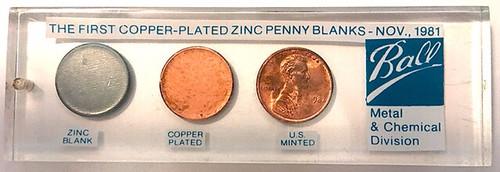
A reader’s antique store find something of a mystery
A reader found an unusual item in an antique store that no one quite recognizes. As Paul Gilkes writes in “Readers Ask,” the collector found a small package dating to about 1982 that illustrates the conversion to a new composition for the Lincoln cent that year. The item features an unplated zinc blank, a copper-plated zinc planchet, and a 1982 Lincoln copper-plated zinc cent. The package was labeled as being from Ball Metal & Chemical Division, the producer of the planchets.
Gilkes contacted several authorities, including Jarden Zinc Products, which was spun out of Ball some years ago. A firm spokesman said that no one at the company remembered the “fascinating” souvenir.
To read the complete article, see:
Reader finds mysterious souvenir of zinc cent conversion in an antique
store: Inside Coin World (https://www.coinworld.com/news/us-coins/2017/11/reader-find-mysterious-zinc-cent-antique-store-inside-coin-world.html)
THE BOOK BAZARRE
AWARD MEDALS OF GEORGE DE HEVESY OFFERED

Hevesy Nobel Medal for Chemistry
(i) Nobel Medal for Chemistry, in 23 carat gold, by Erik Lindberg, obv., bust of Alfred Nobel left, rev., INVENTAS VITAM IUVAT EXCOLUISSE PER ARTES, allegorical figures of Science holding scroll unveiling Nature holding cornucopia, REG. ACAD. SCIENT. SUEC. below, divided by panel engraved G. HEVESY DE HEVES MCMXLIV, edge marked GULD and dated 1944, 66mm, 207.75g

Hevesy Royal Society’s Copley Medal
(ii) Royal Society’s Copley Medal, in silver-gilt, by Mary Gillick, awarded in 1949, edge engraved PROFESSOR GEORGE CHARLES de HEVESY. For. Mem. R.S., 56.8mm
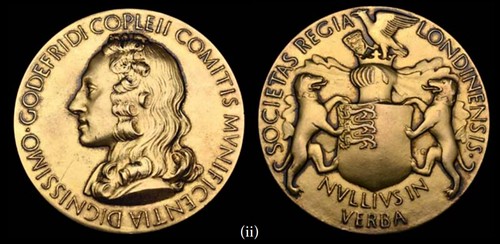
Hevesy Royal College of Physicians’ Baly Medal,
(iii) Royal College of Physicians’ Baly Medal, in silver, by J.S. and A.B. Wyon, edge engraved GEORGE DE HEVESY. 1951, 58mm
[Unless you're a Nobel Laureate, I wouldn't recommend the storage procedures used at Niels Bohr's Institute of Theoretical Physics in Copenhagen during World War II. The Institute had been a refuge for German Jewish physicists since 1933. -Editor]
"Max von Laue and James Franck had deposited their medals there to keep them from being confiscated by the German authorities. After the occupation of Denmark in April 1940, the medals were Bohr's first concern, according to the Hungarian chemist George de Hevesy (also of Jewish origin and a 1943 Nobel Laureate in Chemistry), who worked at the institute.
In Hitler's Germany it was almost a capital offense to send gold out of the country. Since the names of the Laureates were engraved on the medals, their discovery by the invading forces would have had very serious consequences.
To quote George de Hevesy (Adventures in Radioisotope Research, Vol. 1, p. 27, Pergamon, New York, 1962), who talks about von Laue's medal: "I suggested that we should bury the medal, but Bohr did not like this idea as the medal might be unearthed. I decided to dissolve it.
While the invading forces marched in the streets of Copenhagen, I was busy dissolving Laue's and also James Franck's medals. After the war, the gold was recovered and the Nobel Foundation generously presented Laue and Frank with new Nobel medals."
"de Hevesy wrote to von Laue after the war that the task of dissolving the medals had not been easy, as gold is "exceedingly unreactive and difficult to dissolve." The Nazis occupied Bohr's institute and searched it very carefully but they did not find anything. The medals quietly waited out the war in a solution of aqua regia."
To read the earlier E-Sylum article, see: INTERESTING NOBEL PRIZE MEDAL LORE (http://www.coinbooks.org/esylum_v09n51a30.html)
To read the complete sale catalog, see:
http://www.mortonandeden.com/pdfcats/90web.pdf
COIN MARKS 50TH ANNIVERSARY OF SEALAND MICRONATION
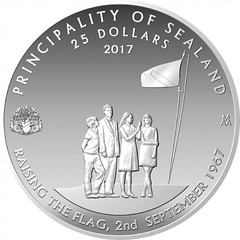
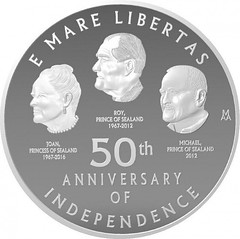
The treasury of the Principality of Sealand, the world’s only man-made and self-proclaimed independent micro-nation, have unveiled (15th September) the designs for their commemorative coin. The coin is to be issued in celebration of the 50th anniversary of Sealand’s declaration of independence, which occurred on the 2nd September 1967. On that day 50 years ago, four members of the Bates family, along with friends and supporters, raised the principality’s newly designed flag for the first time on the tower of Fort Roughs—an abandoned fortress built during the Second World War. Accompanied by his wife, Joan; his fourteen-year-old son, Michael; and his sixteen-year-old daughter, Penelope, Roy Bates founded an independent nation. From that day, the newly created sovereign, Prince Roy, successfully declared this man-made fortress island in the North Sea the independent Principality of Sealand. Prince Roy claimed jus gentium (law of nations) over a tiny part of the globe that was terra nullius (nobody’s land). Joan became the territory’s co-ruler as sovereign princess on the same day, which was also her 38th birthday.
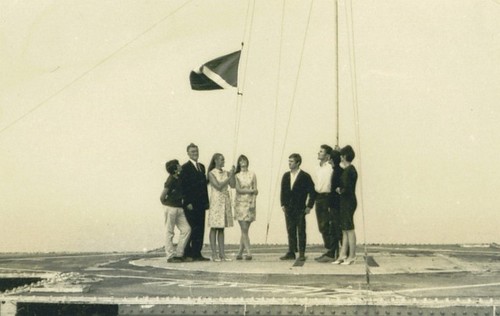
This is the second authorised commemorative coin since 2012 and was approved on the 1st September, one day before the actual independence celebrations. It is designed by Michael Alexander (author of this article) and will be struck to Proof quality by the Tower Mint, United Kingdom, on behalf of the treasury of the Principality of Sealand. The design on the reverse side of the coin is inspired by an actual photograph which was taken the very moment when Sealand’s flag was raised for the first time by Princess Joan.
To read the complete article, see:
Sealand: For 50th anniversary of independence, new silver coin
celebrates a remarkable story (http://news.coinupdate.com/sealand-for-50th-anniversary-of-independence-new-silver-coin-celebrates-a-remarkable-story/)

MACERATED CURRENCY BUST OF PRESIDENT HARRISON

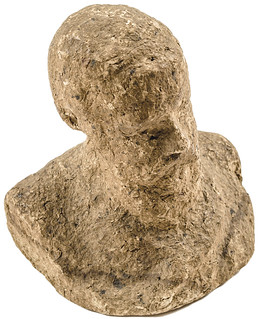
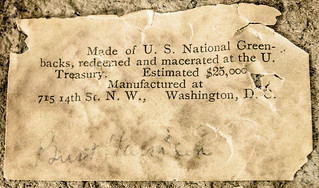
c. 1900, Macerated Currency Bust Portrait upon a Pedestal of President Benjamin Harrison, “Made of U.S. National Greenbacks, redeemed and macerated at the U.(S.) Treasury.” Choice Very Fine.
This original made c. 1900 Large size Macerated Currency Bust of President Benjamin Harrison upon a Pedestal that measures about 4.5" tall. Its original printed Paper Label affixed to the bottom of the base reads: “Made of U.S. National Greenbacks, redeemed and macerated at the U.(S.) Treasury. Estimated $25,000. Manufactured at 715 14th St. N.W., Washington, D.C.” The paper tag is fully intact having some wear, and there is some faint handling to the bust yet it has no major distractions and appears nice for display. This extremely rare example is the one and only President Benjamin Harrison large Bust Portrait upon a Pedestal we have seen and offered.
Souvenirs made of Macerated Paper Money are collected by a handful of people, and are sold at paper-money shows. Instead of burning old U.S. National Greenback bills as they do today, the staff at the U.S. Treasury Department used to shred them and sell chopped pieces to souvenir manufacturers.
From the 1890s until the Hoover administration, souvenir stands in the capital sold busts of the presidents, American Eagles, top hats, vases, slippers, postcards and models of Washington landmarks made of macerated currency and suitable for parlor ornaments.
Your top hat containing $2,000 worth of old bills probably cost 35 cents at the turn of the century.
Hats, Washington Monuments and Abe Lincoln upon a small card are among the more common souvenirs; far rarer are the large busts of Presidents Grover Cleveland, William McKinley and George Washington. They are worth several hundred dollars or more. A simple postcard with a picture of the Treasury building on it was auctioned recently at a paper-money show in Memphis for $260.
They look rather moldy but on close inspection, you can see bits of green paper and red thread and sometimes dollar signs or numbers on the surface. The macerating process was carefully controlled by the Treasury Department. According to an advertising notice on the backs of some of the souvenirs, the old notes being exchanged for new were shipped to Washington and turned over to a special destruction committee of four that watched over the shredding and dissolution.
To read the complete lot description, see:
President Benjamin Harrison Macerated Currency Rare Large Bust Portrait “Made of U.S. National
Greenbacks” (https://www.earlyamerican.com/Auctions/ClientPages/lots.item.php?auction=98&lot=264)
A LIST OF COIN MAKER WEB SITES
While we prioritize sites in English, other languages are welcome if the sites contain good information. Here's a listing of coin maker sites. Let me know what you think of these, and if there are any major sites you think are missing and ought to be included. Thanks. -Editor
Banknote Makers
Bureau of Engraving and Printing
De La Rue
Bullion Makers
Coin Makers (Fantasy)
Campaign Coins
Fantasy Coin LLC
Shire Post Mint
Coin Makers
Royal Australian Mint
The Perth Mint
The Austrian Mint
Royal Mint of Belgium
The Mint of Brazil
The Royal Mint
Grunal Moneta
Royal Canadian Mint
Croatian Mint
Czech Mint
Finland Mint
Monnaie de Paris
The Italian Mint
The Mint of Japan
The Royal Mint of Malaysia
Dutch Mint
New Zealand Mint
Royal Norwegian Mint
Polish State Mint
The Singapore Mint
The Slovakian Mint
South African Mint
The Spanish Mint
The Swiss Mint
Central Mint of China
Pobjoy Mint
Sunshine Minting
United States Mint
Medal Makers
The Tower Mint
Medalcraft Mint
Medallic Art Company
Northwest Territorial Mint
Token Makers
Badger Mint
Hoffman Mint
Mardi Gras Doubloons
Nevada Coin Minting
Old Time Wooden Nickel Co.
The Osborne Coinage Company
The Osborne Coinage Company (TokensDirect)
The Patrick Mint
To visit the Newman Numismatic Portal, see:
https://nnp.wustl.edu/
To read the earlier E-Sylum articles, see:
A LIST OF COIN BLOG WEB SITES (http://www.coinbooks.org/v20/esylum_v20n30a28.html)
A LIST OF COIN FORUM WEB SITES (http://www.coinbooks.org/v20/esylum_v20n31a14.html)
A LIST OF COIN PERIODICAL WEB SITES (http://www.coinbooks.org/v20/esylum_v20n32a09.html)
A LIST OF COIN DATABASE WEB SITES (http://www.coinbooks.org/v20/esylum_v20n37a11.html)
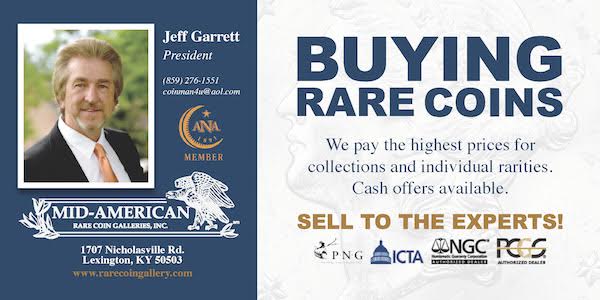
RICHARD III GOLD HALF ANGEL UNEARTHED
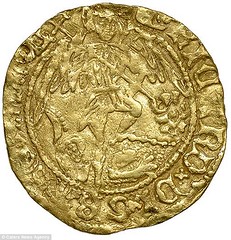
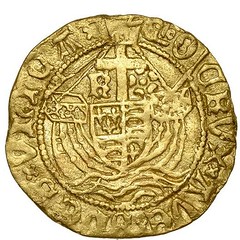
A gold coin more than 500 years old has been discovered by an amateur treasure hunter close to the battlefield where Henry Tudor triumphed over Richard III in the Wars of the Roses.
Michelle Vall, a teaching assistant from Blackpool, found the coin, a half angel, during a charity metal-detecting event at Monks Kirby in Warwickshire in September. The site is 11 miles south of Bosworth Field in Leicestershire.
The coin was minted during the two-year reign of Richard III — the last Yorkist king, who was killed during the battle in 1485 — and is one of only a handful in existence. The coin measures about 2cm in diameter and weighs less than 3g and is expected to fetch £15,000 at auction.
The coins were introduced in 1472 during the reign of Richard’s brother Edward IV.
Ms Vall, 51, spent two and a half hours in the field before discovering the coin. “It was deep down, about 16 inches below the surface, and the soil there is thick clay so it took a bit of digging out,” she said. “I spotted this glint of gold in the hole, although I obviously did not know exactly what it was at first.
Experts have speculated that the coin may have been dropped by one of Richard’s soldiers fleeing the battle after he was killed by men loyal to Sir William Stanley. It is up for auction on December 13 at a sale of coins, historical medals and paper money at the auctioneer Dix Noonan Webb in London.
Christopher Webb, head of the coins department, said: “This is a very rare discovery that has miraculously survived in a Warwickshire field for more than five centuries.
“Its importance as a coin is enhanced by the tantalising possibility that it may have belonged to one of Richard’s army whose defeat at Bosworth ended the Wars of the Roses and ushered in the Tudor dynasty.”
To read the complete article, see:
Fleeing army may have dropped Richard III gold coin
(https://www.thetimes.co.uk/article/fleeing-army-may-have-dropped-richard-iii-gold-coin-h8fwxqbsc)
To read the complete article, see:
500-year-old coin that may have been dropped by one of Richard III's soldiers fleeing the Battle of Bosworth
Field is found by an amateur treasure hunter (/sciencetech/article-5092541/500-year-old-coin-amateur-treasure-hunter.html)
ISLAMIC GOLD COIN HOARD UNEARTHED IN FRANCE
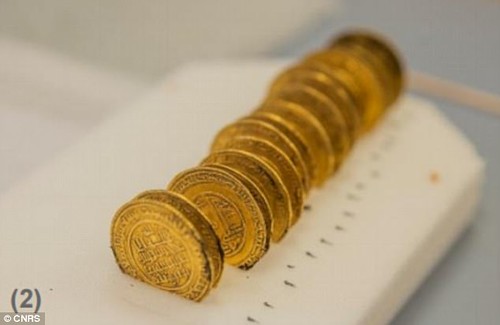
Archaeologists have discovered an 'exceptional' treasure trove of precious objects at the Abbey of Cluny, a former Benedictine monastery in France's Saône-et-Loire
More than 2,000 objects have been found, including silver deniers - or pennies - Islamic gold coins, a signet ring and several gold items.
The discovery is the first time that gold coins from the Arab lands, silver French deniers and a signet ring have ever been found together in a single, enclosed complex.
Researchers from the Universite Lumiere Lyon discovered the items as part of an archaeological dig at the Abbey of Cluny, which started in 2015.
The team discovered 2,200 silver deniers and oboles - a silver-alloy coin of France issued during the Middle Ages - in a cloth bag.
They were mostly minted by the Abbey of Cluny and probably dated to the first half of the 12th century.
These were found alongside a tanned hide bundle containing 21 Islamic gold dinar coins dated between 1121 and 1131 from Spain and Morocco, under the reign of Ali ibn Yusuf (1106-1143).
To read the complete article, see:
'Exceptional' medieval treasure trove of 2,200 pieces of silver, 21
Islamic gold coins and a stunning signet ring are found in a French abbey after being buried for more than eight centuries
(http://www.dailymail.co.uk/sciencetech/article-5084983/Archaeologists-buried-medieval-treasure-French-abbey.html)
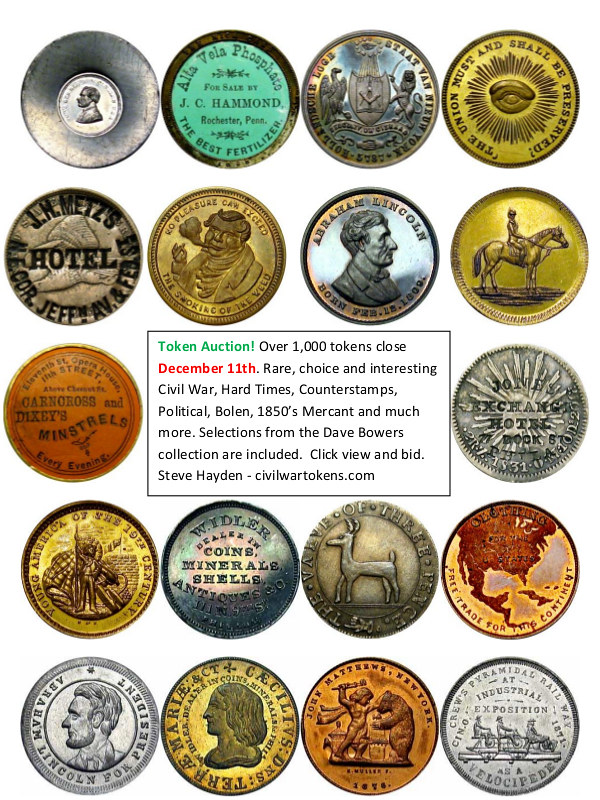
SPECIAL FORCES DOG AWARDED DICKIN MEDAL
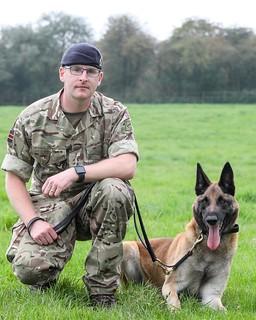 A special forces dog that detected explosives and insurgents during an assault on a Taliban position in Afghanistan has been given a prestigious award for gallantry.
A special forces dog that detected explosives and insurgents during an assault on a Taliban position in Afghanistan has been given a prestigious award for gallantry.
Mali, a Belgian Malinois, received the Dickin medal for saving the lives of Special Boat Service troops during the 2012 operation.
The Dickin medal has been described by the PDSA charity that awards it as the animal equivalent of the Victoria Cross, the UK’s highest honour for gallantry.
Cpl Daniel Hatley, who trained Mali when the dog was a puppy, said: “I am extremely proud of Mali. The way he conducted himself when it mattered most enabled my colleagues to achieve success in close combat.”
Mali’s special forces handler, who cannot be named for security reasons, was also awarded a gallantry medal for his part in the operation.
During his deployment with the Special Boat Service, Mali was credited with giving British forces the upper hand in a near eight-hour operation to dislodge a heavily armed Taliban force from a multi-storey building.
He was wounded by three grenade blasts, but still managed to indicate the locations of enemy fighters. That gave the British forces time to react in close-quarters combat.
The dog was sent through direct fire twice and was hoisted up the outside of the building several times to provide the assault force with a foothold. The first two explosions that wounded Mali caused injuries to his chest, front and rear legs.
Another detonated close to his face, causing the loss of his front tooth and damage to his ear. But Mali continued to push forward and remained close to his handler.
The PDSA described the dog as an “incredibly worthy recipient” of the medal. “Being awarded the PDSA Dickin medal recognises Mali’s vital role within the force that day,” Hatley said.
To read the complete article, see:
Army dog wins ‘animal Victoria Cross’ for Taliban counterattack
(https://www.theguardian.com/world/2017/nov/17/army-dog-wins-animal-victoria-cross-for-taliban-counterattack)
To read earlier E-Sylum articles, see:
DICKIN MEDAL WINNER PADDY THE PIGEON (http://www.coinbooks.org/v20/esylum_v20n31a34.html)
STATUE DEDICATED TO DICKIN MEDAL DOG (http://www.coinbooks.org/v20/esylum_v20n44a27.html)
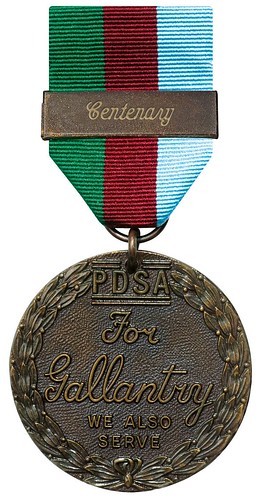 Director general of the PDSA, Jan McLoughlin, said: "Mali has displayed a truly awesome ability and determination to seek out explosives and insurgents during a key operation.
Director general of the PDSA, Jan McLoughlin, said: "Mali has displayed a truly awesome ability and determination to seek out explosives and insurgents during a key operation.
"To achieve this while exposed to close combat and such intense enemy attack makes him an incredibly worthy recipient of the PDSA Dickin Medal.
"It is even more poignant that we were able to make Mali's award today on our charity's 100th birthday."
Eight-year-old Mali is the 69th recipient of the medal, which was presented to him at a ceremony in London on Friday.
The medal was first introduced by the veterinary charity's founder Maria Dickin in 1943 and is a large bronze medallion bearing the words "for gallantry" and "we also serve".
In the years since its creation, a total of 31 other dogs, 32 World War messenger pigeons, four horses and one cat have also joined the roll of honour.
To read the complete article, see:
Heroic Mali receives the Dickin Medal - the canine Victoria Cross - for brave Afghanistan
mission (http://www.leicestermercury.co.uk/news/local-news/heroic-mali-receives-dickin-medal-797642)

KYRGYZ REPUBLIC BANKNOTE USES MOTION SURFACE
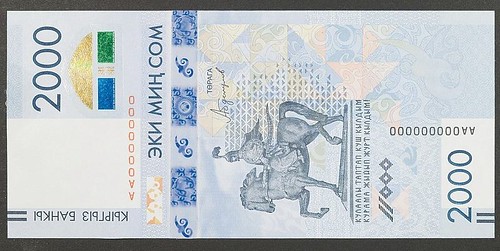
Crane Currency’s first banknote with Motion Surface, a new micro-optics security feature was issued on Friday by a country in central Asia.
Motion Surface, made at Crane Currency’s Nashua plant, incorporates three dimensionality and fluid movement.
The company’s first banknote with the new anti-counterfeiting feature was printed as a commemorative banknote issued by the National Bank of Kyrgyzstan. It is also the country’s first currency printed in vertical orientation rather than horizontal.
“We are thrilled. This new product is very well received from the marketplace,” Stephen DeFalco, CEO of Crane Currency, said on Friday.
The Kyrgyz Republic’s 2,000 som commemorative banknote celebrates the 25-year anniversary of the independence of the Kyrgyz Republic and the establishment of its national currency.
The Motion Surface micro-optic security feature cannot be replicated, according to DeFalco. “This family of products has the strongest anti-counterfeiting method in the country today,” he said.
DeFalco could not comment on how many commemorative banknotes were printed for the National Bank of Kyrgyzstan, but said the 2,000 som denomination equates to about $28 in American money.
Motion Surface is the newest of three anti-counterfeiting products produced by Crane. The company has been working on it for about four years, DeFalco said.
Crane Currency supplies banknotes for central banks all over the world and has continually supplied the United States Treasury with its currency paper since 1879.
To read the complete article, see:
First banknote issued with new security design made in Nashua
(http://www.unionleader.com/article/20171119/NEWS02/171119242/0/NEWS04)
THE GHOST AND THE WIDOW'S MITES
... none of the ghosts that ever graced Brooklyn with their "presence" had so prominent a progenitor as that of Henry Ward Beecher himself. Beecher is one of the best known and most celebrated Brooklynites of all time. The first preacher of Plymouth Church served his congregation for forty years, and in the course of his long public life he certainly had his fair share of controversy and scandal, but they had to do with affairs of a more earthly nature such as adultery and gluttony. Still, Henry Ward Beecher is mostly remembered for social activism, his long ministerial service and abolitionism. He masterminded famous “slave auctions” during which the public donated money and valuables to secure the freedom of several enslaved women and girls.
How did this man who spent his lifetime in service of God get ensnared in these dark matters?
Enter Dr. Isaac K. Funk.
Dr. Isaac Kaufmann Funk was the founder of Funk & Wagnalls publishing company, famous for its dictionaries, as well as a Lutheran minister, editor and lexicographer. Despite his religious occupation, he was drawn to spiritualism and psychic research and often attended “spiritualistic sittings.” In full fairness, as fashionable as Spiritism was at the time, there was always a healthy measure of skepticism about it.
However, “The Case of the Widow’s Mites” would have corrupted even the most cynical of minds.
During a séance, in 1903, the ghost of a John Rakestraw made an unexpected appearance and, speaking on behalf of the ghost of Henry Ward Beecher, accused I.K. Funk of harboring ancient coins, so-called “Widow’s Mites,” which he had borrowed years ago from Charles E. West and never returned.
Professor Charles Edwin West was a prominent educator, as well as an enthusiastic numismatist who amassed a valuable collection of ancient and rare coins. He was also a close and loyal friend of Henry Ward Beecher and remained by his side during the turbulent period of the Beecher-Tilton trial when many of the preacher’s friends turned away from him.
 Funk and West, both friends of Beecher, surely belonged to the same society circles and knew each other rather well, since Mr. West agreed to lend Dr. Funk two “Widow’s mites” from his
collection. Isaac Funk wanted to include the images of the coins as an illustrative plate for the dictionary which he was preparing at that time. Funk & Wagnalls' “Standard Dictionary of the
English Language” was published in 1895. Professor Charles West passed away in 1900. Dr. Funk was positively sure that he had returned the coins to their rightful owner. That is ... until the ghost
appeared and confronted him – on behalf of another ghost! He insisted that the coins were still in Dr. Funk’s possession and that Henry Ward Beecher wanted them returned where they belonged.
Funk and West, both friends of Beecher, surely belonged to the same society circles and knew each other rather well, since Mr. West agreed to lend Dr. Funk two “Widow’s mites” from his
collection. Isaac Funk wanted to include the images of the coins as an illustrative plate for the dictionary which he was preparing at that time. Funk & Wagnalls' “Standard Dictionary of the
English Language” was published in 1895. Professor Charles West passed away in 1900. Dr. Funk was positively sure that he had returned the coins to their rightful owner. That is ... until the ghost
appeared and confronted him – on behalf of another ghost! He insisted that the coins were still in Dr. Funk’s possession and that Henry Ward Beecher wanted them returned where they belonged.
Isaac Funk was flabbergasted. He even confronted the spectral John Rakestraw and interrogated him on the details of the loan and the lender. And it looked like the ghost knew what he was talking about. He gave all the right answers, to Dr. Funk’s considerable dismay. He also mentioned that the coins were kept in an iron box.
Next day, back in the editorial office, Funk shared this encounter with his brother and colleagues. E. J. Wheeler, the editor of The Literary Digest, who decidedly did not believe in “spirit communications,” egged Dr. Funk on: “Now, find that coin. It would be a good test." They summoned the company cashier and asked him to search the strong box they kept in the office. Twenty minutes later, as Dr. Funk wrote in his 1904 book “The Widow’s Mite and Other Psychic Phenomena," “one of the assistants came into the office, and handed me an envelope in which were two 'Widow’s Mites'. The envelope had been found in a little drawer in a large iron safe under a lot of papers, where it had lain forgotten for a number of years.”
Just like “John Rakestraw” said.
The coins were promptly returned to Charles West’s heirs.
To read the complete article, see:
A strange case of Widow's Mite, or the Ghosts Come Knocking
(https://www.bklynlibrary.org/blog/2017/10/26/strange-case-widows-mite)

FEATURED WEB SITE: MUSEUM OF THE ITALIAN MINT
This week's Featured Web Site is the Museum of the Italian Mint.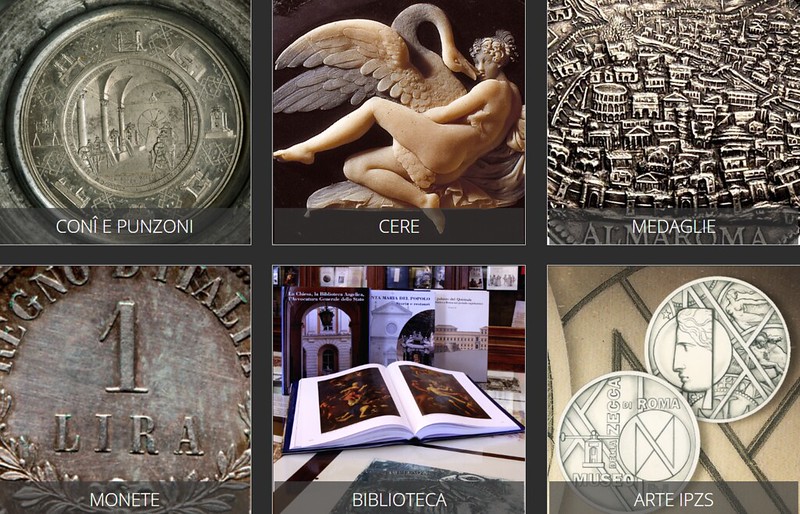
http://www.museozecca.ipzs.it/collezione/home.html

